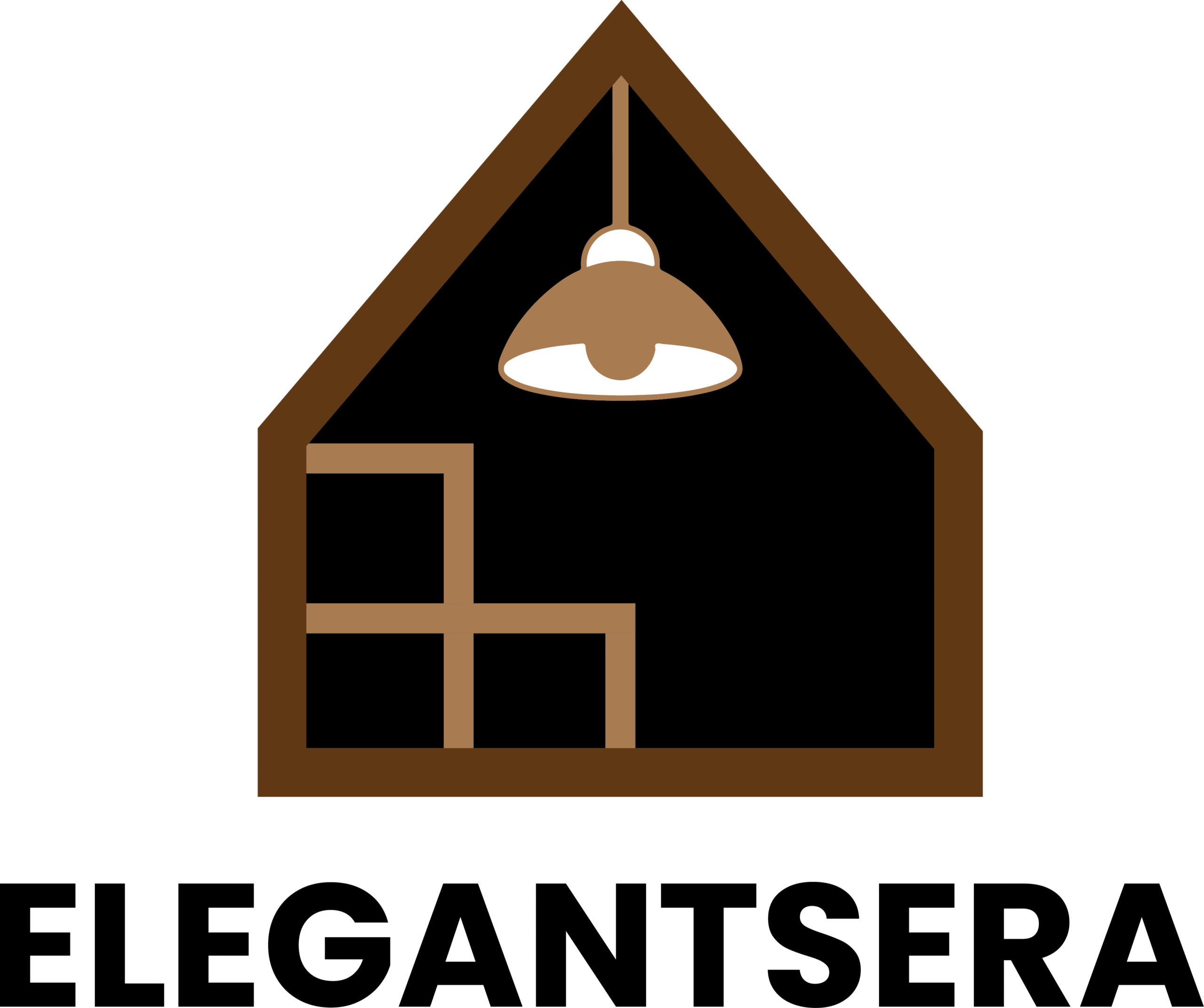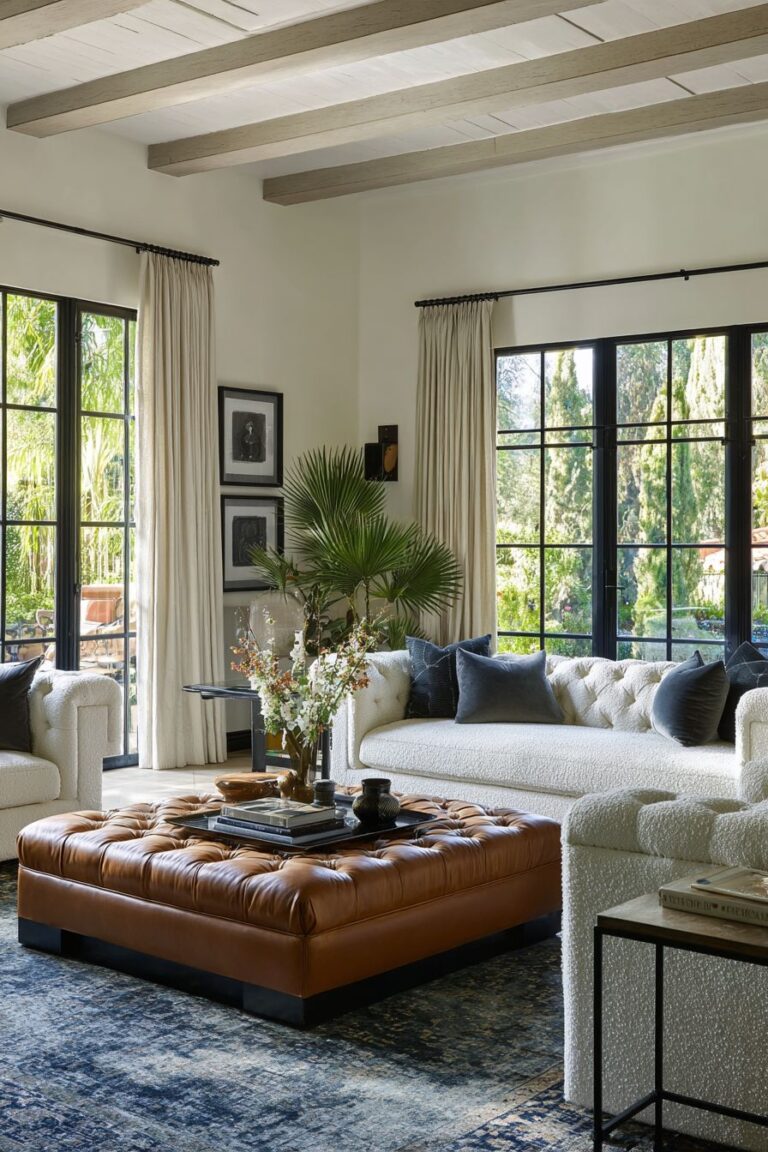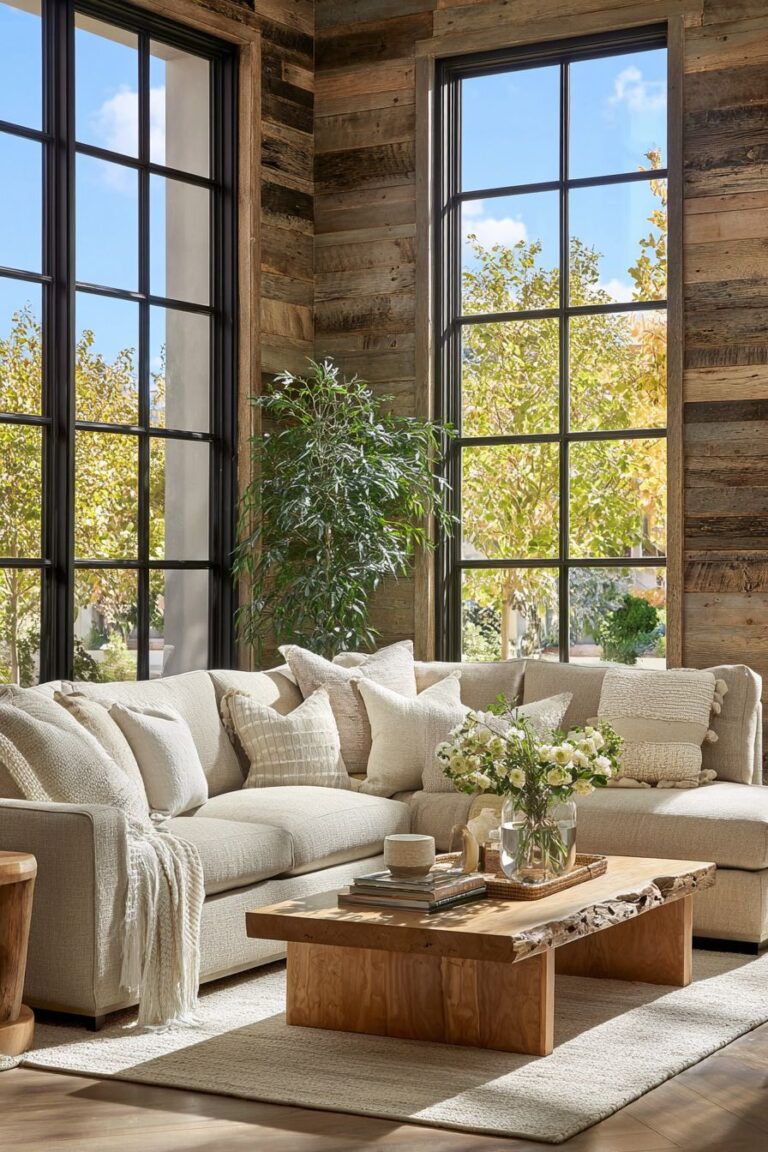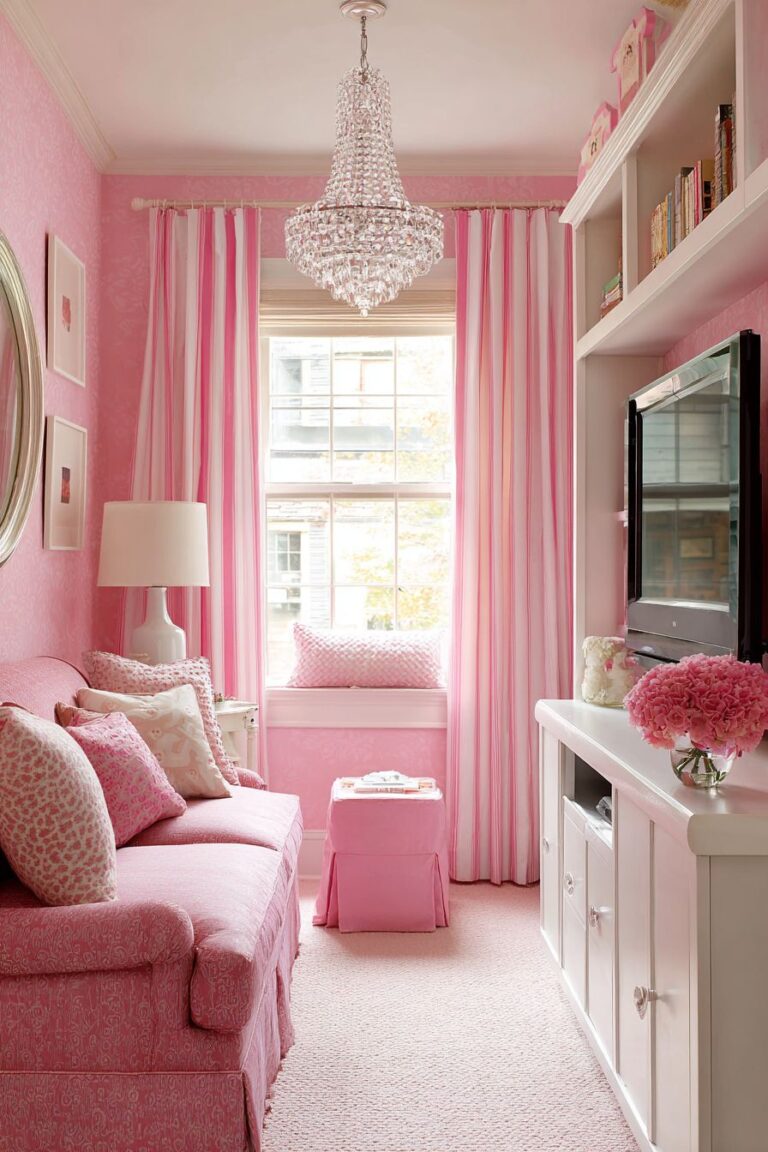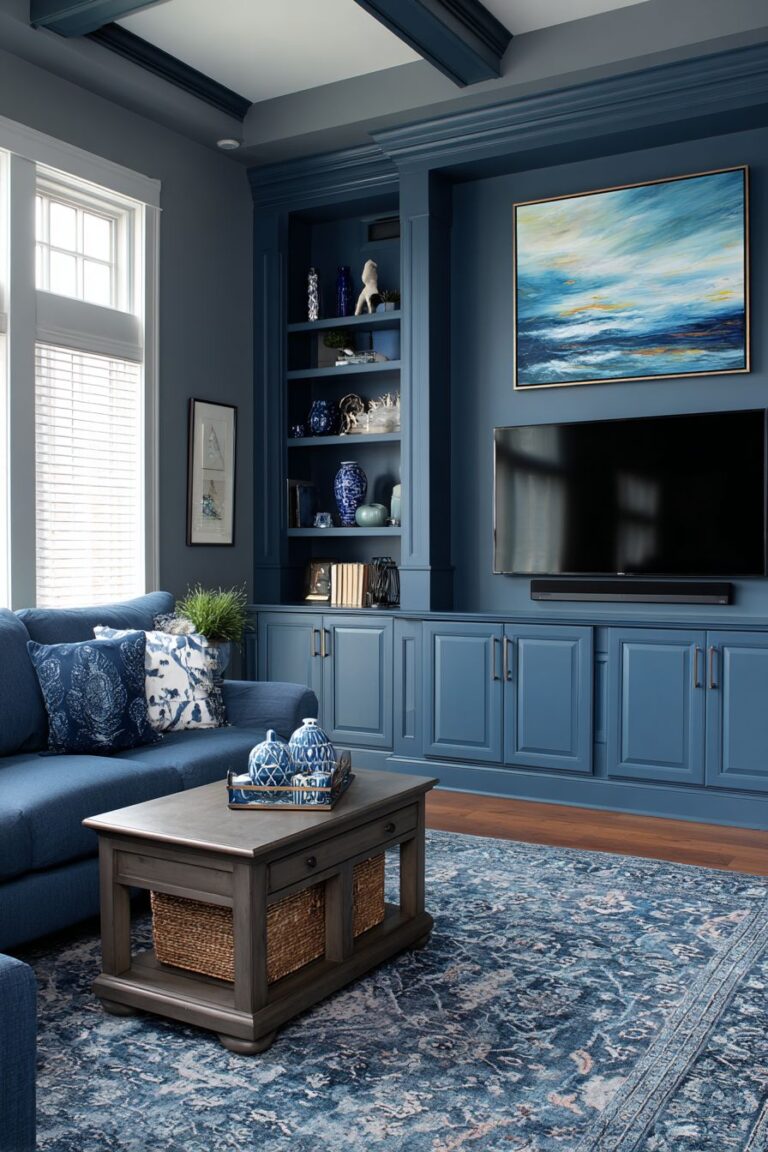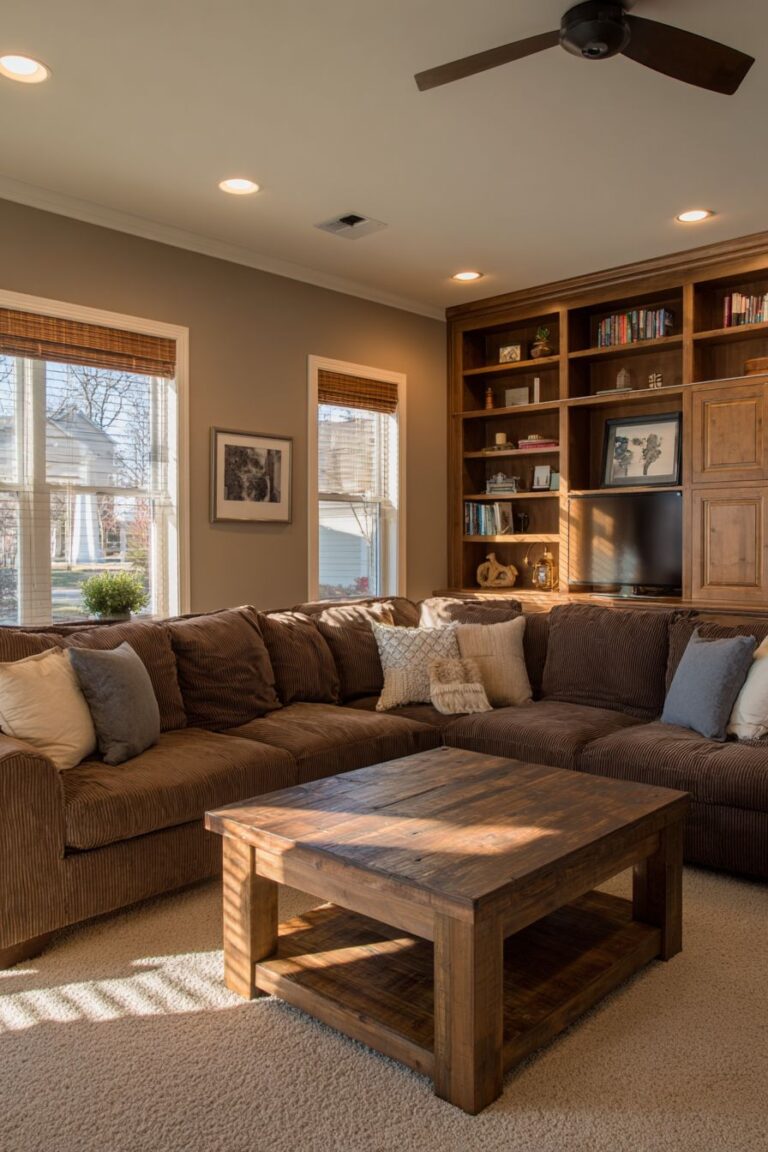20 Stunning Black Couch Living Room Ideas: Design to Transform Your Space
The black couch has evolved from a bold statement piece to a versatile cornerstone of contemporary interior design. Far from being merely a dark, imposing presence, today’s black sofas and sectionals serve as sophisticated anchors that can adapt to virtually any design aesthetic, from sleek modern minimalism to cozy farmhouse charm. The beauty of incorporating a black couch into your living room lies in its remarkable ability to serve as both a neutral foundation and a dramatic focal point, depending on how you style the surrounding elements.
In the world of interior design, the black couch represents more than just seating—it embodies confidence, elegance, and timeless appeal. Whether you’re drawn to the luxurious feel of black velvet, the durability of leather, or the casual comfort of cotton canvas, a black couch offers endless possibilities for creating a space that reflects your personal style. This comprehensive guide explores twenty distinct approaches to styling black couch living rooms, each showcasing unique design philosophies that cater to diverse lifestyles and preferences.
From the clean lines of Scandinavian minimalism to the rich textures of bohemian eclecticism, these design concepts demonstrate how a single furniture piece can anchor entirely different aesthetic visions. Each approach offers valuable insights into color theory, spatial composition, material selection, and lighting strategies that will help you create a living room that’s both functional and visually stunning.
1. Modern Minimalist Sophistication

The modern black couch living room epitomizes contemporary elegance through its commitment to clean lines and sophisticated simplicity. Picture a sleek charcoal sectional with razor-sharp edges positioned strategically against a pristine white accent wall, creating an immediate visual impact through high contrast. The black leather upholstery displays subtle grain textures that catch and reflect soft natural light streaming through expansive windows, adding depth and interest to what might otherwise be a stark composition.
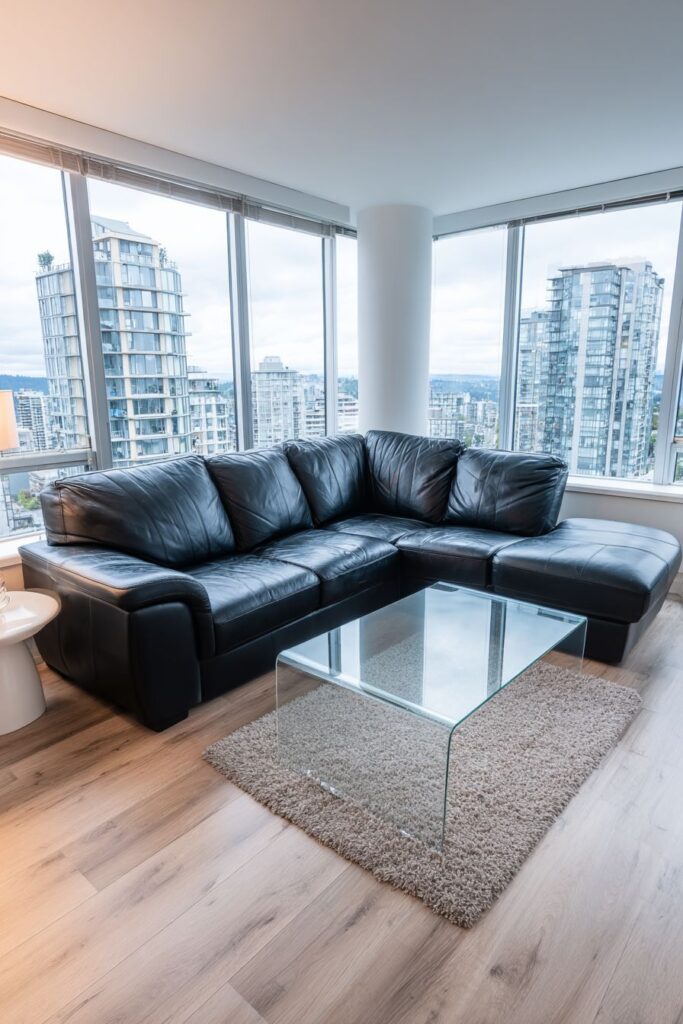
The supporting furniture maintains the minimalist philosophy with a transparent glass coffee table that seems to float effortlessly above the floor, paired with crisp white side tables that echo the wall’s neutral backdrop. These elements work together to create visual breathing room while maintaining functionality. The neutral wool area rug serves as a textural bridge between the hard surfaces and soft seating, its subtle weave adding tactile interest without competing for attention.
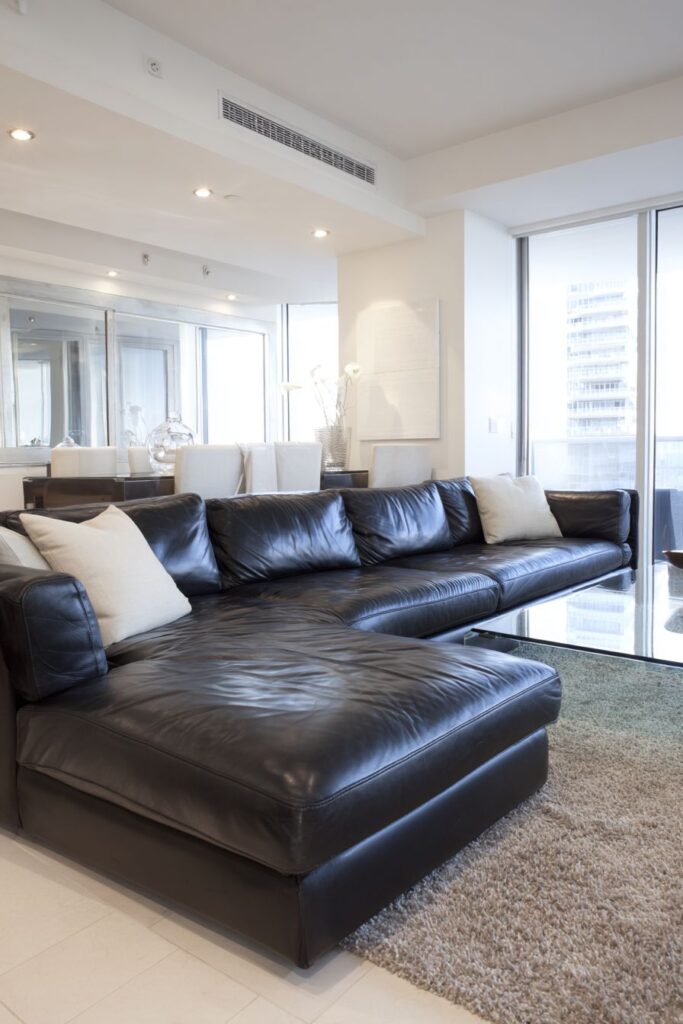
Lighting plays a crucial role in this modern aesthetic, with natural illumination taking precedence during daylight hours. The large windows not only flood the space with light but also create dynamic shadow patterns that shift throughout the day, adding an ever-changing element to the otherwise static composition. The sophisticated monochromatic palette relies on texture and form rather than color to create visual interest, resulting in a timeless design that won’t feel dated in years to come.
The wide-angle perspective reveals how thoughtful furniture arrangement can make even a compact space feel expansive and uncluttered. This approach to modern living emphasizes quality over quantity, with each piece carefully selected for both form and function.

Key Design Tips:
- Choose a sectional with clean, geometric lines to establish the modern foundation
- Maintain a strict color palette of black, white, and gray with minimal accent colors
- Invest in high-quality leather or performance fabrics that will age beautifully
- Use transparent furniture pieces like glass tables to maintain visual lightness
- Maximize natural light with minimal window treatments or sheer panels
2. Cozy Family Comfort Zone
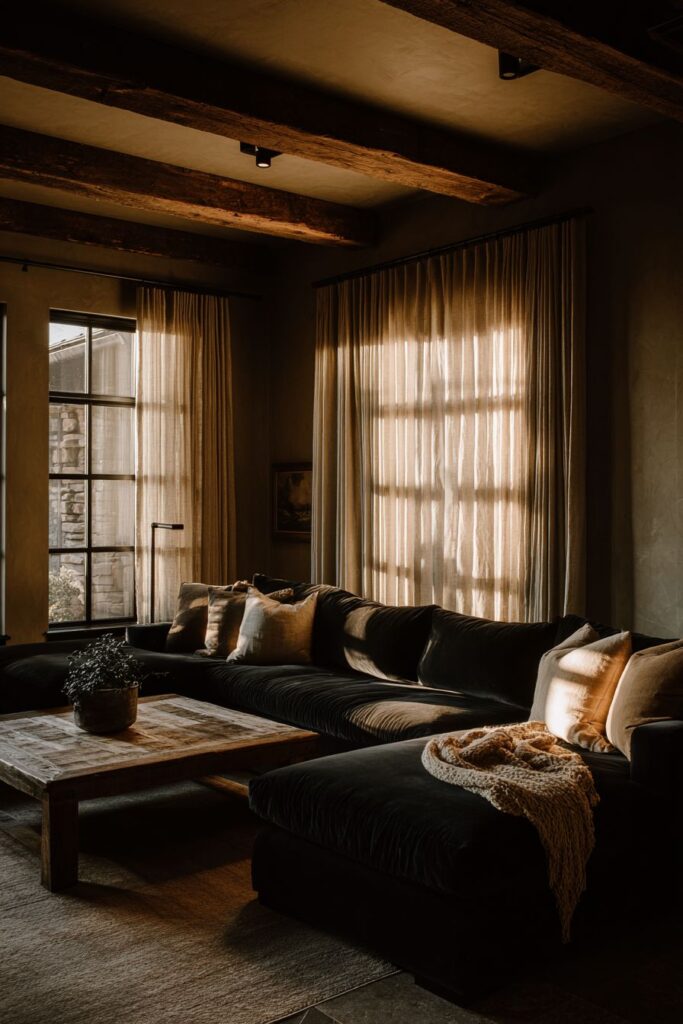
Transform your living space into a welcoming family haven with a plush velvet sectional in deep charcoal that invites relaxation and conversation. This approach prioritizes comfort without sacrificing style, featuring a generously proportioned sofa that can accommodate the whole family while maintaining its elegant appearance. The rich velvet upholstery adds a layer of luxury that feels both sophisticated and approachable, perfect for creating a space where formal entertaining and casual movie nights coexist seamlessly.
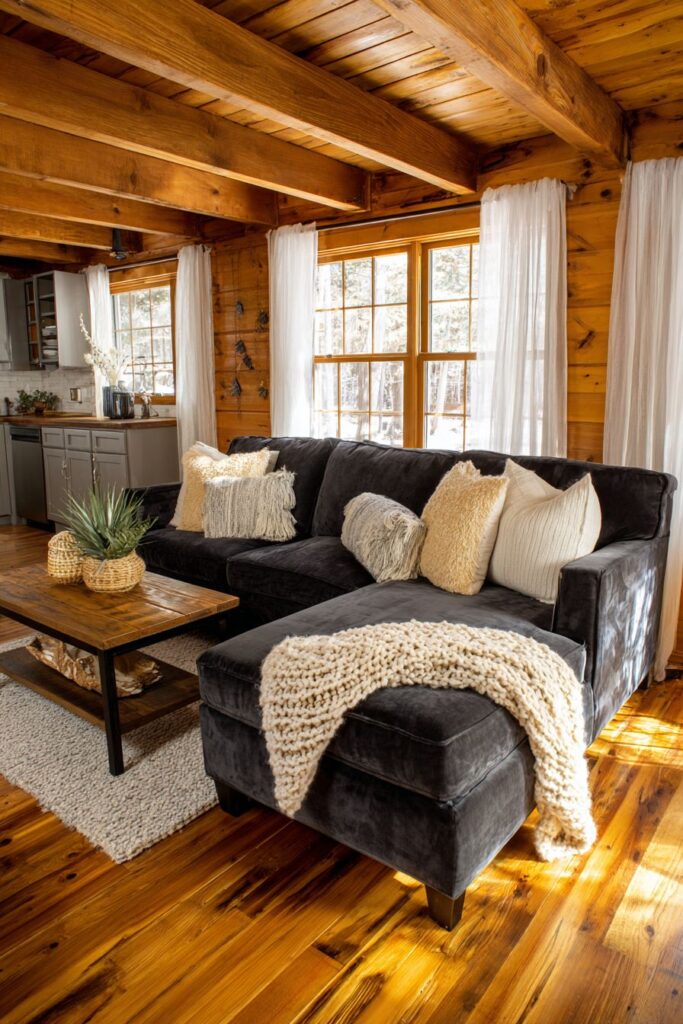
The warmth of this design comes from thoughtful layering of textures and colors that soften the dramatic black foundation. Cream and camel-toned throw pillows introduce subtle color variation while providing additional comfort, their soft hues creating a beautiful contrast against the dark velvet. A chunky knit throw draped casually over one arm suggests spontaneous relaxation and adds visual interest through its organic draping and textural variety.

Natural materials play a essential role in creating the cozy atmosphere, with natural oak flooring and exposed wooden beams adding architectural warmth that balances the cool tones of the black upholstery. These wood elements bring organic beauty into the space while establishing a connection to nature that feels grounding and authentic. The rustic wood coffee table serves as both a functional surface and a textural counterpoint to the sleek sofa lines.
Golden hour lighting streaming through sheer curtains creates magical moments throughout the day, casting soft shadows that highlight the fabric textures and create an ever-changing ambiance. This natural illumination works in harmony with strategically placed table lamps to ensure comfortable lighting for various activities, from reading to entertaining.
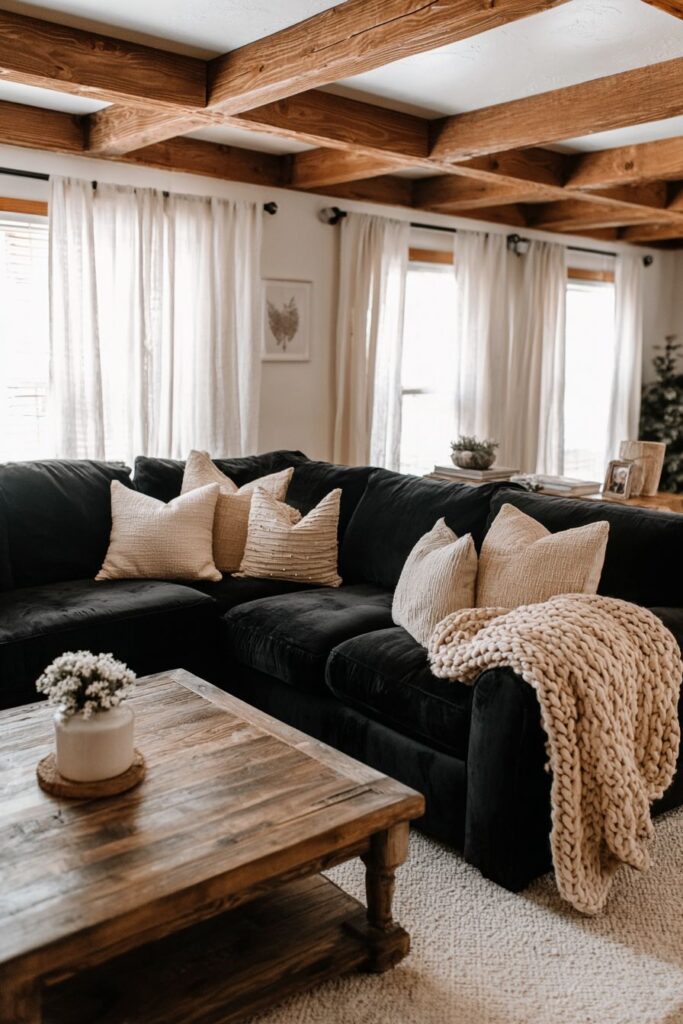
Key Design Tips:
- Select velvet or microfiber upholstery for ultimate comfort and rich texture
- Layer warm-toned throw pillows and blankets to soften the black foundation
- Incorporate natural wood elements to add warmth and organic beauty
- Use sheer window treatments to filter light while maintaining privacy
- Position the sectional to encourage conversation and family interaction
3. Scandinavian Simplicity Perfected
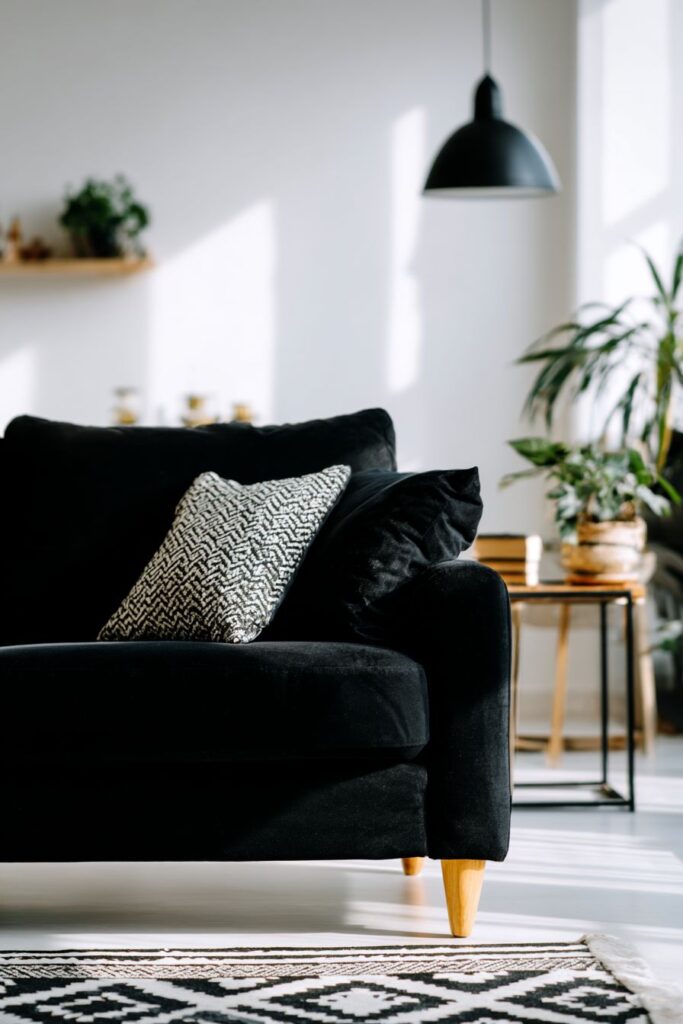
The Scandinavian approach to black couch styling celebrates functional beauty through streamlined design and natural materials. A sleek sofa with characteristic light oak wooden legs creates an immediate connection to Nordic design principles, where form follows function in the most elegant way possible. The matte black fabric provides sophisticated contrast while maintaining the understated elegance that defines Scandinavian aesthetics, proving that dramatic elements can coexist with minimalist sensibilities.

Crisp white walls serve as the perfect backdrop for this carefully curated composition, their pristine surface reflecting natural light throughout the space and creating the bright, airy feeling that’s essential to Nordic design. Blonde wood side tables echo the sofa’s wooden legs, creating visual continuity while providing practical surfaces for lighting and accessories. This consistent use of light woods against the white and black palette creates harmony without monotony.
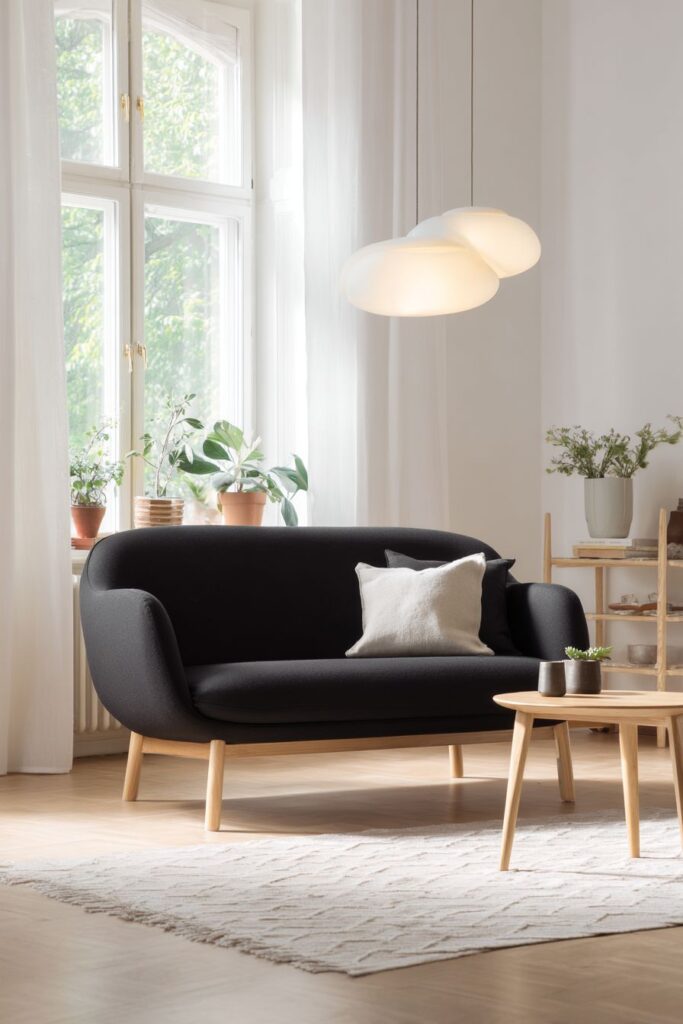
The geometric wool rug introduces pattern and texture while maintaining the neutral color story that’s fundamental to Scandinavian style. Its structured design adds visual interest to the floor plane while its natural fibers contribute to the overall sense of organic comfort. The rug’s neutral tones bridge the gap between the stark black and white elements, creating a cohesive foundation for the furniture arrangement.
Minimalist pendant lighting demonstrates the Nordic commitment to functional beauty, providing necessary illumination through sculptural forms that enhance rather than dominate the space. Potted plants serve dual purposes, adding organic elements that connect the interior to nature while contributing to the health and vitality of the living environment. Professional interior photography would capture the clean lines and functional beauty characteristic of this aesthetic approach.

Key Design Tips:
- Choose furniture with exposed wood legs in light oak or birch finishes
- Maintain a strict neutral palette with whites, blacks, and natural wood tones
- Add geometric patterns through rugs or textiles rather than wall treatments
- Include living plants to bring nature indoors and purify the air
- Select lighting fixtures that combine functionality with sculptural appeal
4. Small Space Smart Solutions

Urban apartment living demands creative approaches to maximizing limited square footage, and a compact two-seater black couch can be the perfect solution for creating a stylish living area without overwhelming the space. Strategic positioning becomes crucial in small spaces, with the charcoal upholstery providing sophisticated style while the modest scale ensures adequate traffic flow and visual breathing room. The subtle texture in the fabric adds interest without creating visual weight that might make the space feel cramped.

Floating shelves mounted above the sofa serve multiple functions, providing display space for books and minimal decor while drawing the eye upward to create the illusion of height. This vertical storage solution eliminates the need for bulky bookcases or entertainment centers that would consume precious floor space. The carefully curated selection of displayed items reflects personal style while maintaining the clean aesthetic that’s essential in compact living situations.

The round metal coffee table with glass top represents smart furniture selection for small spaces, its transparent surface maintaining visual lightness while the compact round shape allows for easier navigation around the seating area. The combination of metal and glass materials complements the black upholstery while contributing to the urban aesthetic that’s often desirable in city apartments.

Recessed lighting provides ambient illumination without consuming any visual or physical space, a crucial consideration when every square inch matters. This approach to lighting eliminates the need for table lamps or floor lamps that would compete for surface space or floor area. The wide-angle lens perspective reveals how thoughtful furniture selection and arrangement can make even the smallest space feel functional and stylish.

Key Design Tips:
- Select appropriately scaled furniture that fits the room’s proportions
- Utilize vertical space with floating shelves for storage and display
- Choose furniture with transparent or reflective surfaces to maintain visual lightness
- Implement recessed lighting to save space while providing adequate illumination
- Position seating to create clear traffic patterns and maximize functionality
5. Industrial Urban Loft Character

The industrial aesthetic celebrates raw materials and honest construction, making a tufted leather sectional the perfect centerpiece for this urban loft approach. The rich black leather develops character over time, showing natural wear patterns and authentic patina that enhance rather than diminish its appeal. This furniture choice embodies the industrial philosophy of celebrating materials that improve with age and use, creating a living space that tells a story through its evolving surfaces.

Exposed brick walls provide the essential textural backdrop that defines industrial style, their rough surfaces and earthy colors creating dramatic contrast with the sleek leather upholstery. These architectural elements speak to the building’s history while providing visual weight that grounds the design. The brick’s natural variations in color and texture ensure that no two walls look exactly alike, adding organic interest to the structured environment.

The metal coffee table with distinctive hairpin legs exemplifies mid-century industrial design, its minimal framework supporting a functional surface while maintaining visual lightness. Concrete floors contribute to the urban loft aesthetic while providing durability and easy maintenance—practical considerations that align with industrial design principles. These hard surfaces might seem cold, but they’re balanced by the warmth of the leather seating and strategic lighting choices.
Edison bulb fixtures provide warm ambient lighting that softens the harder edges of the industrial materials while celebrating the beauty of exposed mechanical elements. Large factory-style windows flood the space with natural light during the day, their steel frames and expansive glass panels reinforcing the industrial vocabulary while ensuring the space never feels dark or oppressive despite the dramatic color palette.
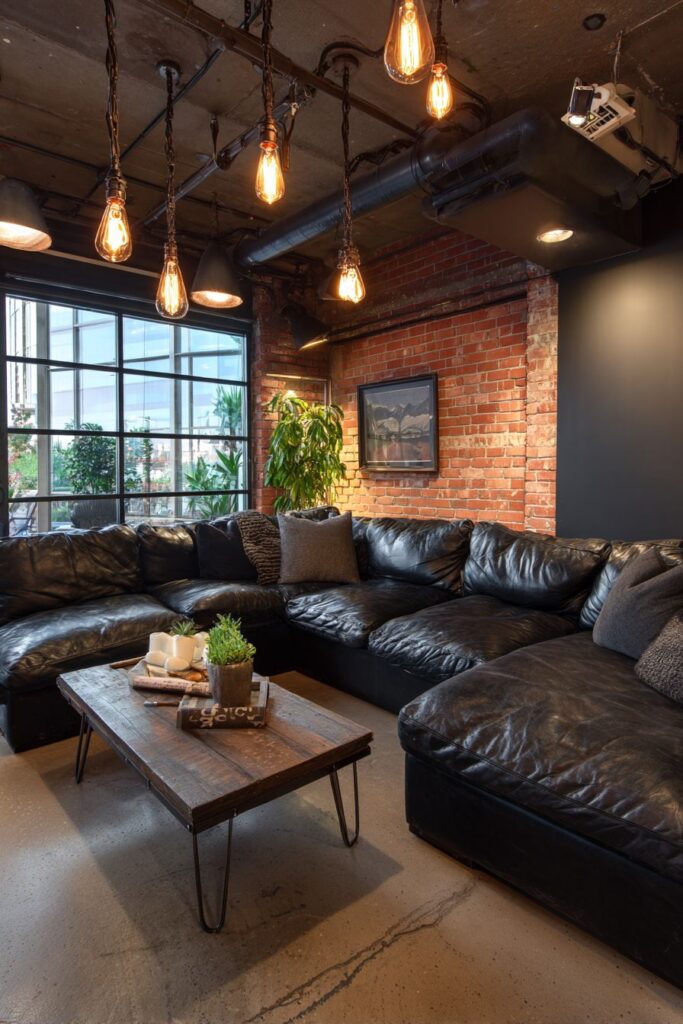
Key Design Tips:
- Invest in genuine leather furniture that will develop beautiful patina over time
- Expose architectural elements like brick walls and steel beams when possible
- Choose furniture with metal frames and industrial-inspired hardware
- Install Edison bulb fixtures for authentic period lighting with warm ambiance
- Maintain the raw character of materials rather than trying to refinish or polish them
6. Bohemian Eclectic Expression
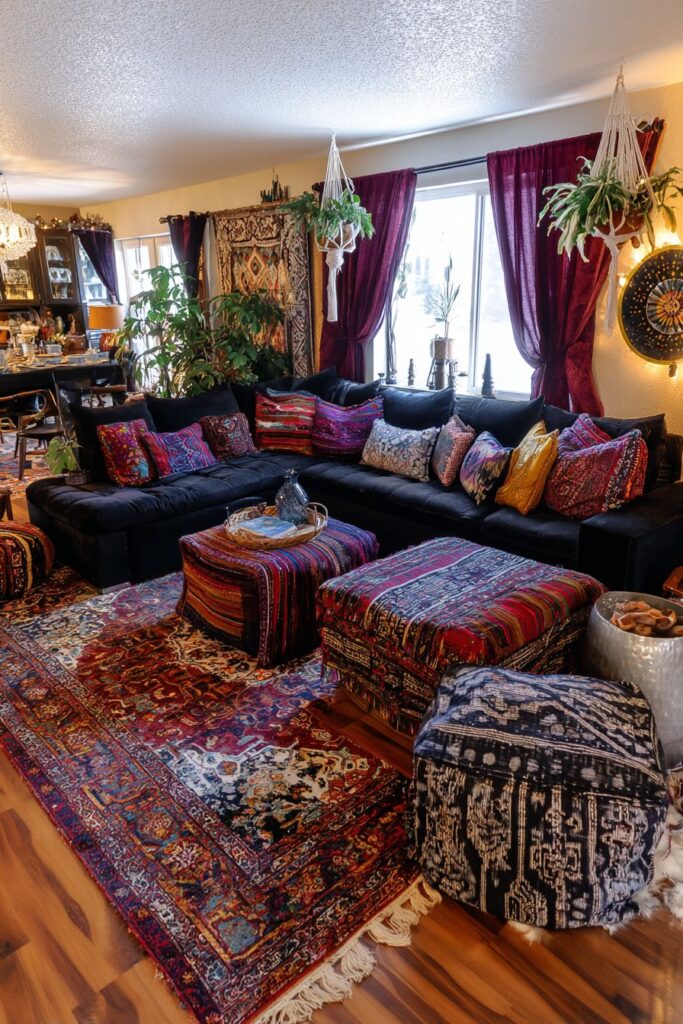
The bohemian approach to black couch styling embraces creative chaos and global influences, using a low-profile sectional as the foundation for an eclectic mix of patterns, textures, and colors. This design philosophy celebrates the beauty of collected treasures from travels and experiences, creating a space that feels personally curated rather than professionally designed. The black upholstery provides a neutral anchor that allows colorful accessories to shine without overwhelming the composition.
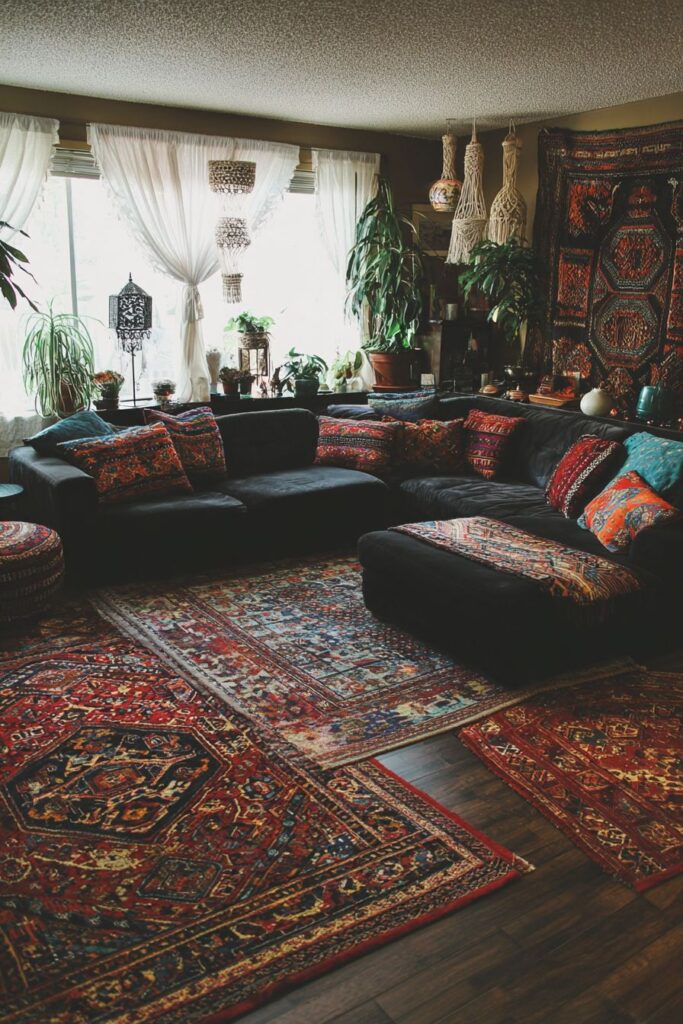
Colorful throw pillows in jewel tones and ethnic patterns transform the simple black sectional into a canvas for artistic expression. These textiles might include Moroccan-inspired geometrics, Indian block prints, or Central American weavings, each contributing to the global narrative that defines bohemian style. The varied patterns and textures create visual richness that invites closer inspection and tells stories of cultural exploration and appreciation.
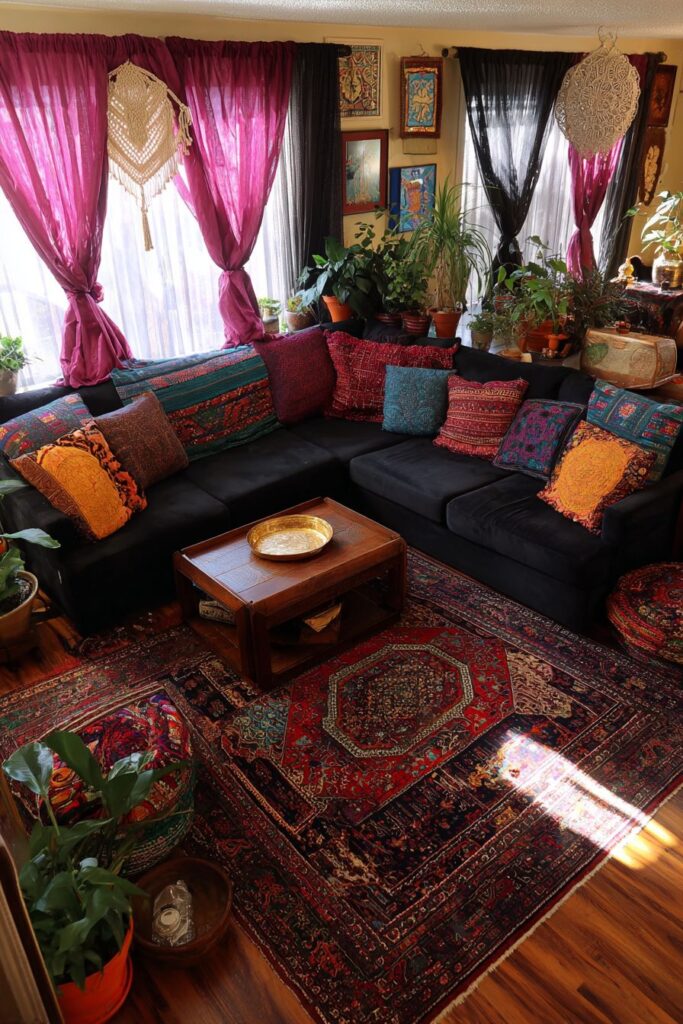
Layered Persian rugs in rich burgundy and gold tones warm the hardwood floors while adding another layer of pattern and cultural reference. This approach to floor treatment creates the foundation for the room’s bohemian character, with traditional motifs and time-worn beauty contributing to the overall sense of collected authenticity. The overlapping rugs create defined zones within the larger space while maintaining the relaxed, non-rigid approach that characterizes boho style.
Macrame wall hangings and abundant plants complete the bohemian atmosphere, introducing organic shapes and natural textures that soften the structured furniture lines. The plants serve practical and aesthetic functions, purifying the air while adding life and movement to the space. Natural lighting filtering through flowing curtains creates dappled shadows that dance across the varied textures, adding yet another dynamic element to this richly layered environment.
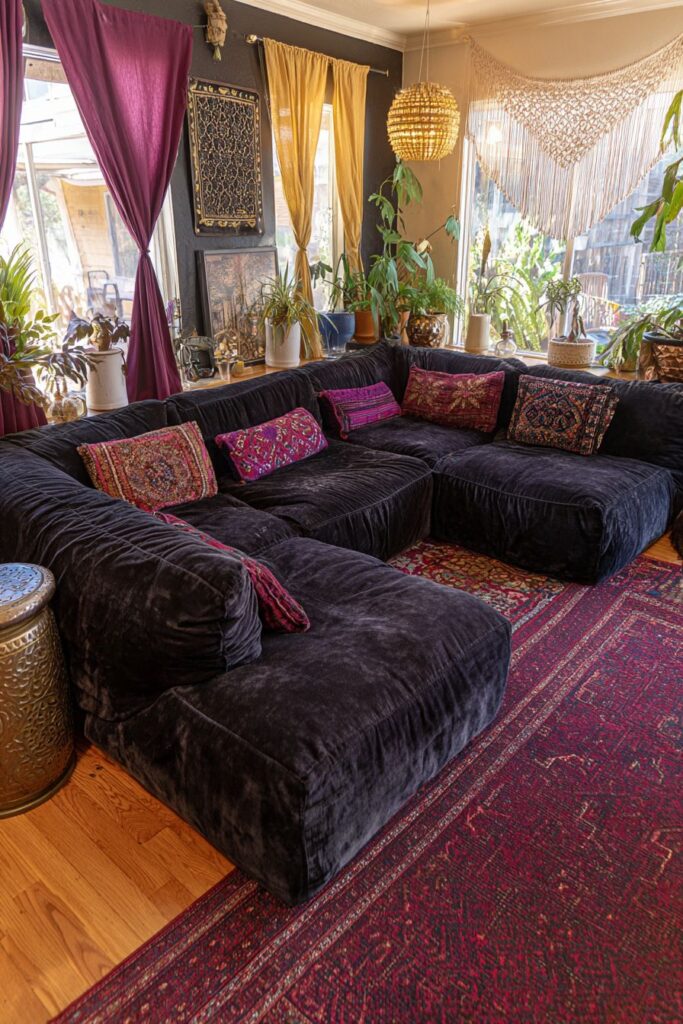
Key Design Tips:
- Layer multiple patterns and textures for authentic bohemian richness
- Include handmade or artisanal accessories that tell cultural stories
- Use plants abundantly to create jungle-like lushness and natural beauty
- Choose warm, saturated colors that complement rather than compete with black
- Allow for casual, unstudied arrangements that feel naturally evolved over time
7. Transitional Timeless Elegance

Transitional design bridges the gap between traditional comfort and contemporary sophistication, making it an ideal approach for those who appreciate both classic and modern elements. A sophisticated three-seater upholstered in charcoal linen blend fabric exemplifies this balanced approach, offering the comfort of traditional seating with the clean lines that appeal to contemporary sensibilities. The linen blend provides both durability and natural texture while maintaining an elegant appearance that works equally well for formal entertaining and casual family time.
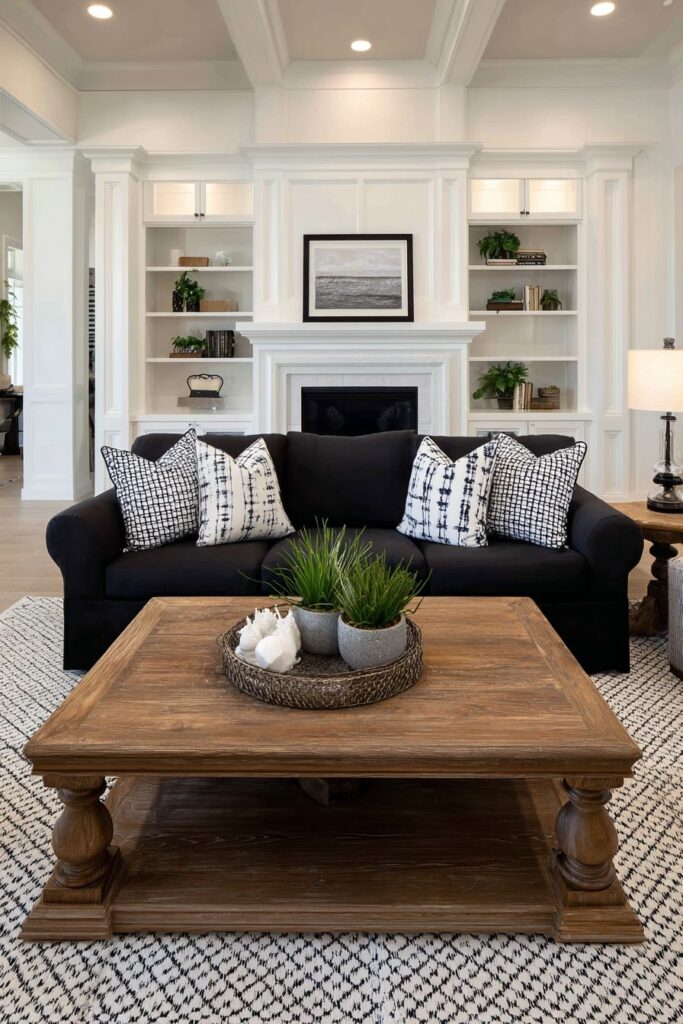
The traditional wooden coffee table with turned legs adds classical detailing that references historical furniture making while maintaining proportions that feel current and uncluttered. This piece serves as the room’s traditional anchor, its craftsmanship and material quality speaking to enduring design principles while its scale and finish keep it from feeling heavy or outdated in the contemporary context.
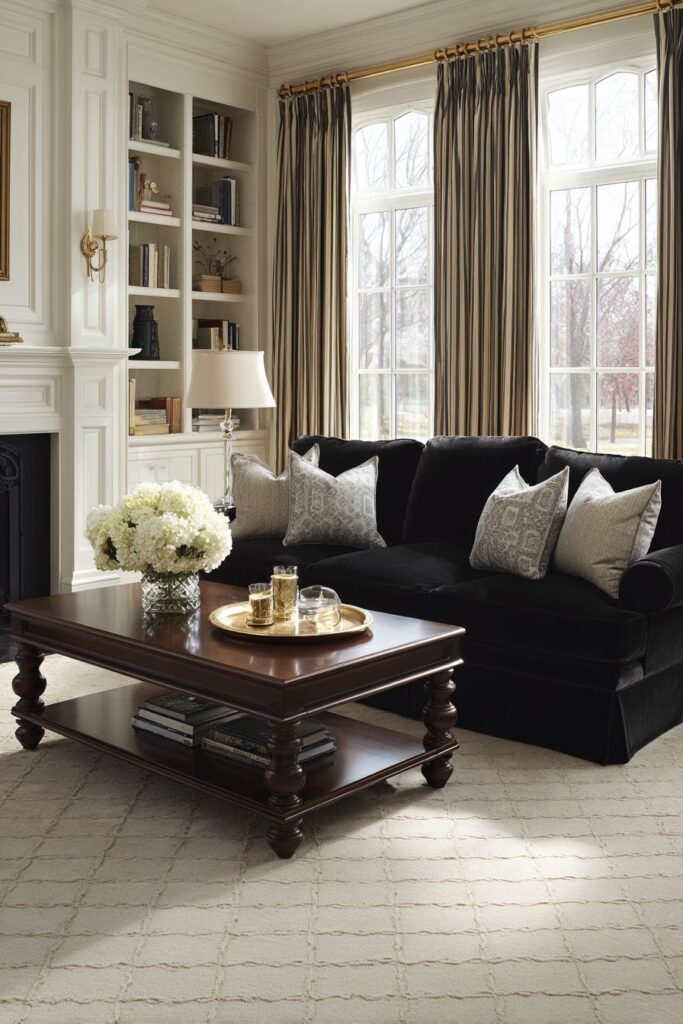
Brass accent lamps provide warm task lighting while introducing metallic elements that bridge traditional and contemporary design languages. The warm brass finish complements both the charcoal upholstery and natural wood elements while providing the functional illumination necessary for reading and other activities. These fixtures demonstrate how lighting can serve both practical and aesthetic purposes while contributing to the overall design cohesion.
Built-in white bookcases framing a fireplace create architectural interest while providing essential storage and display opportunities. This millwork demonstrates the transitional approach to space planning, where traditional elements like fireplaces and built-ins are executed with contemporary restraint and proportion. The neutral area rug with subtle geometric pattern grounds the furniture grouping while adding visual interest through pattern that’s sophisticated rather than busy.
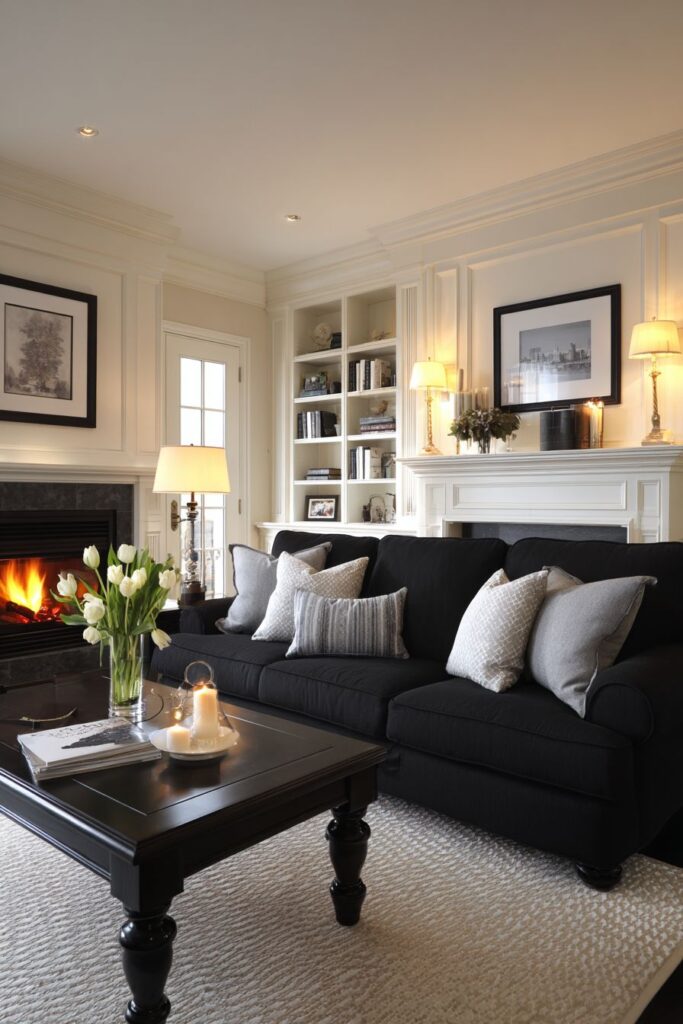
Key Design Tips:
- Balance traditional furniture forms with contemporary proportions and finishes
- Use natural materials like linen and wood that appeal to both design sensibilities
- Include architectural elements like built-ins for storage and visual interest
- Choose brass or bronze metals for warmth without appearing too traditional
- Select patterns that are geometric rather than floral for contemporary appeal
8. Mid-Century Modern Revival
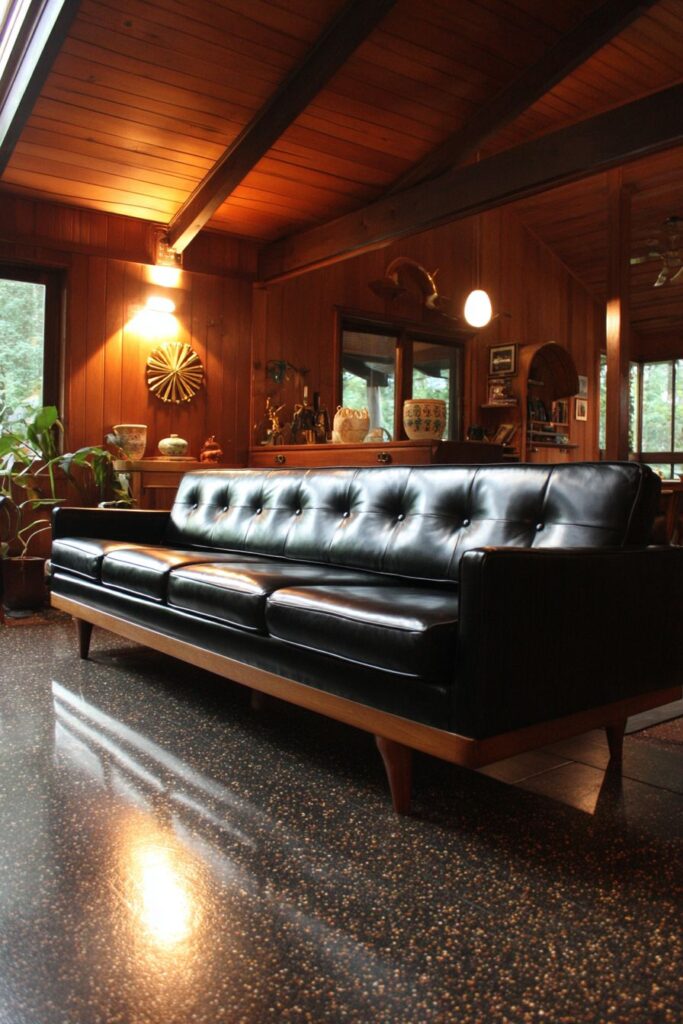
The mid-century modern aesthetic celebrates the design innovations of the 1950s and 1960s, when furniture makers created pieces that were both functional and sculptural. A sleek black sofa with tapered walnut legs and button-tufted back cushions captures the essential elements of this design philosophy, where clean lines meet organic curves in perfect harmony. The walnut wood provides warmth and natural beauty while the precise tapering of the legs demonstrates the period’s commitment to refined craftsmanship.
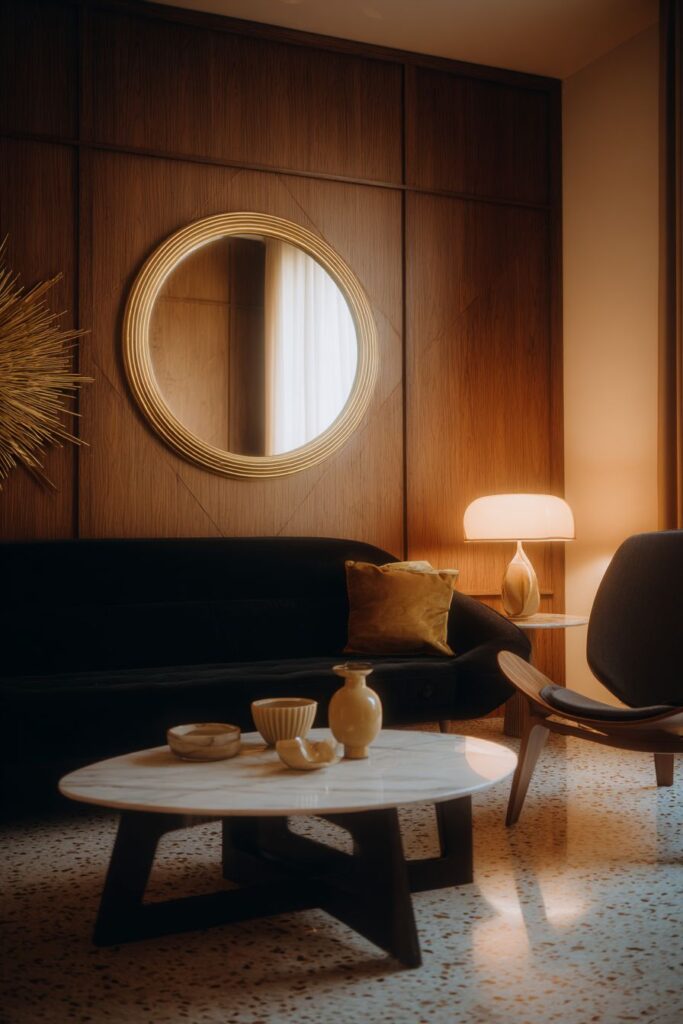
An iconic Eames-style lounge chair completes the mid-century furniture grouping, its molded plywood construction and leather upholstery representing the pinnacle of the era’s design achievements. The geometric coffee table echoes the period’s fascination with abstract forms and experimental materials, creating a cohesive furniture collection that celebrates the optimistic modernism of the post-war era. These pieces work together to create a living space that feels both historically informed and refreshingly contemporary.
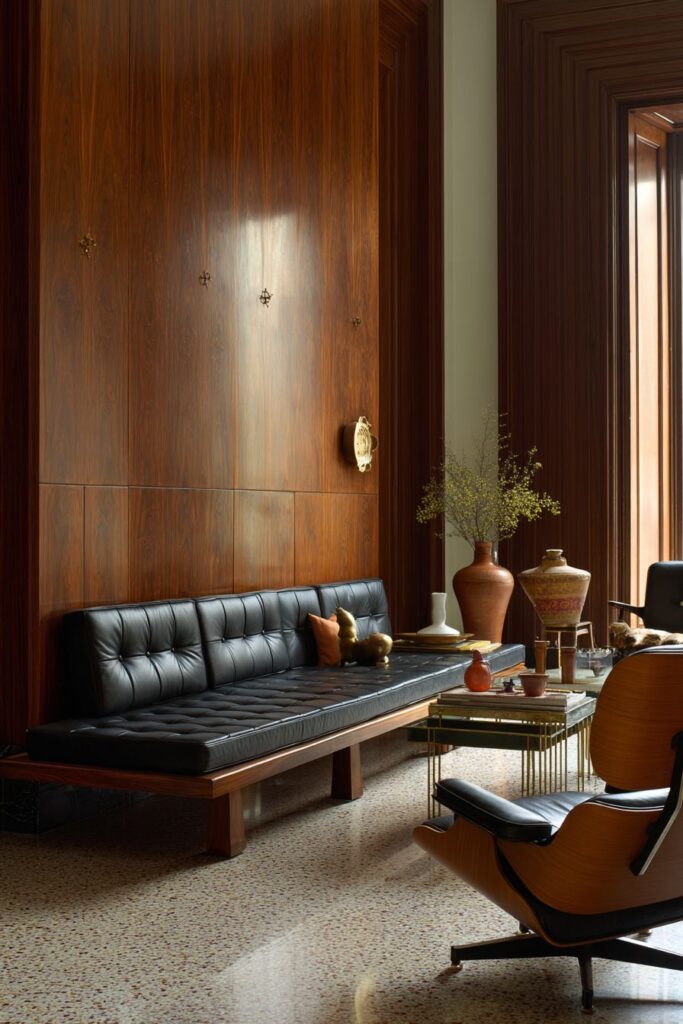
Period-appropriate accessories like a sunburst mirror and ceramic pottery add authentic details that enhance the mid-century narrative without feeling like museum pieces. These decorative elements demonstrate the era’s love of atomic-age motifs and experimental glazes, contributing to the overall aesthetic while serving practical functions. The carefully chosen accessories show how attention to historical detail can enhance rather than constrain contemporary living.
Warm wood paneling and terrazzo flooring provide authentic 1960s ambiance while contributing to the overall material palette that defines mid-century design. These architectural elements create the proper backdrop for the furniture and accessories while establishing the sophisticated color story that makes this aesthetic so enduringly appealing. Professional photography would capture the clean lines and authentic materials with balanced exposure highlighting the rich textures that make mid-century modern design so tactilely appealing.
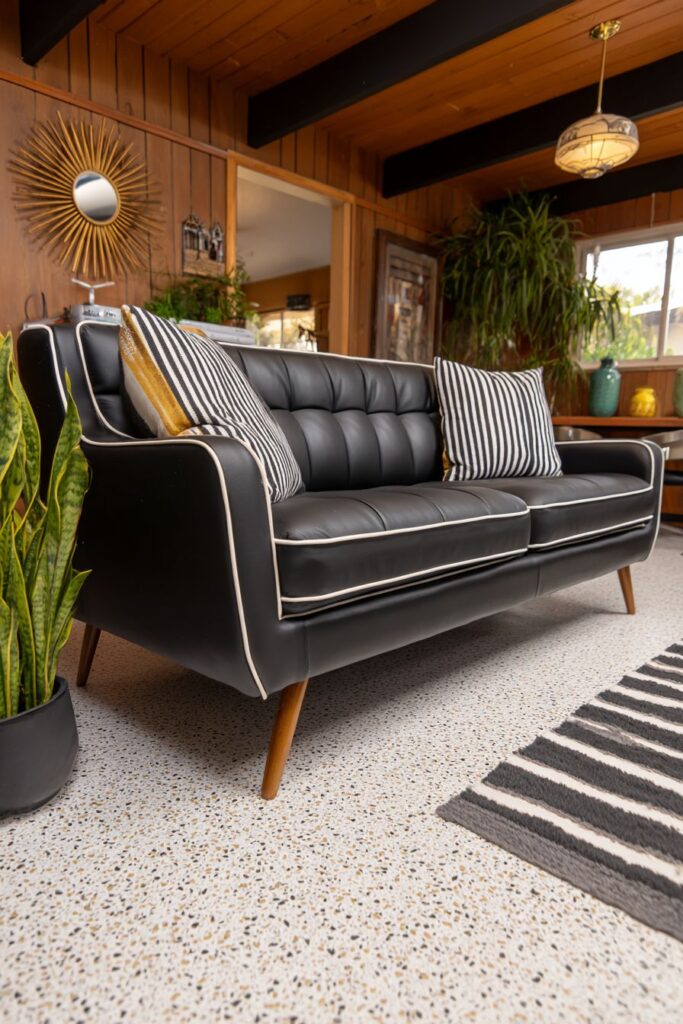
Key Design Tips:
- Look for furniture with tapered legs and organic curves characteristic of the period
- Include iconic pieces or high-quality reproductions from famous mid-century designers
- Choose warm wood tones like walnut, teak, or rosewood for authentic appeal
- Add atomic-age accessories and geometric patterns for period-appropriate detail
- Maintain clean lines and avoid clutter to preserve the modernist aesthetic
9. Farmhouse Casual Comfort

The farmhouse aesthetic brings rural charm and casual comfort into contemporary living spaces, using a black sectional in charcoal cotton canvas as an unexpected modern element within a rustic setting. This approach demonstrates how traditional country style can incorporate contemporary furniture choices without losing its essential character. The cotton canvas upholstery provides durability and casual comfort while maintaining an understated elegance that complements rather than competes with traditional elements.
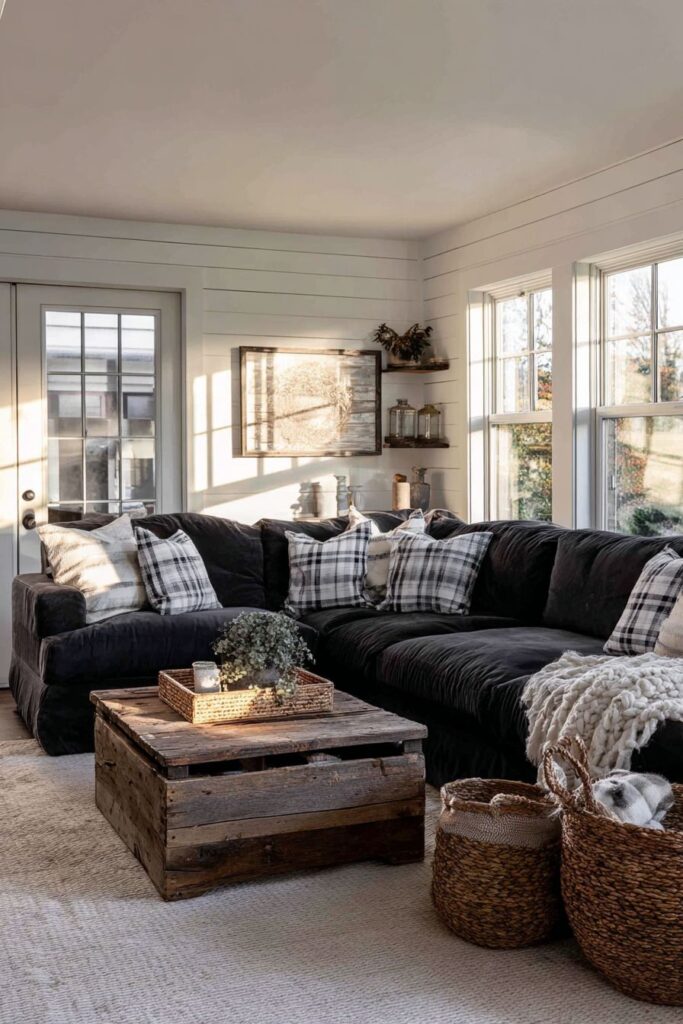
A shiplap accent wall painted in soft white provides the quintessential farmhouse backdrop, its horizontal lines and subtle texture creating visual interest while maintaining the light, airy feeling that’s essential to modern country style. This architectural element references traditional barn construction while being executed with contemporary precision and proportion. The white finish ensures the space feels fresh and clean rather than dark or oppressive.

The distressed wooden coffee table serves both functional and aesthetic purposes, providing a surface for everyday use while adding authentic character through its weathered finish and traditional construction details. Woven baskets offer rustic storage solutions that are both practical and visually appealing, helping to maintain the organized, uncluttered appearance that modern farmhouse style requires. These natural fiber accessories add texture and organic beauty while solving real-world storage needs.
Buffalo check throw pillows and galvanized metal accessories reinforce the country aesthetic without feeling contrived or overly themed. These elements reference traditional farmhouse patterns and materials while being scaled and styled for contemporary comfort. Natural light from divided-light windows creates gentle shadows across the textured fabrics and weathered wood surfaces, adding depth and visual interest throughout the day.

Key Design Tips:
- Mix contemporary furniture with traditional architectural elements for balanced appeal
- Use natural materials like cotton, linen, and weathered wood for authentic texture
- Include practical storage solutions that contribute to the overall aesthetic
- Choose classic country patterns like buffalo check or ticking stripes sparingly
- Maintain a light, airy color palette to prevent the space from feeling heavy
10. Contemporary Urban Sophistication
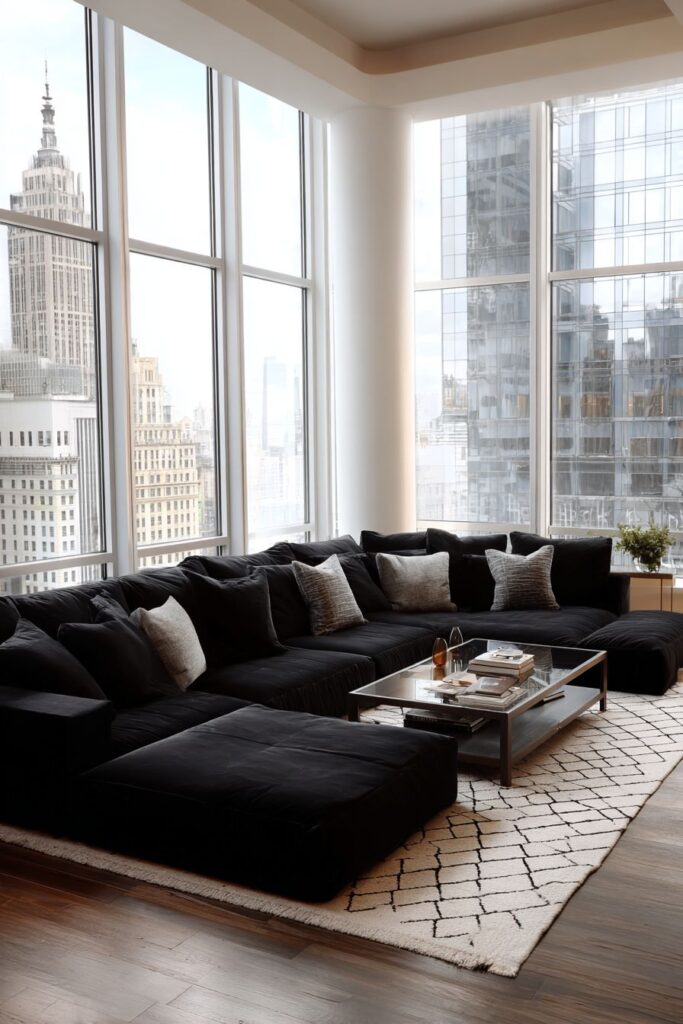
Contemporary design embraces current trends and technologies while maintaining timeless appeal, making a modular sectional system the perfect choice for flexible urban living. The ability to rearrange seating configurations allows residents to adapt their space for different activities and entertaining needs, demonstrating the contemporary emphasis on functionality and adaptability. The matte black upholstery provides sophisticated style while being practical enough for daily use in busy urban environments.

Polished concrete floors exemplify contemporary material choices, offering durability and low maintenance while contributing to the sleek aesthetic that defines modern city living. These surfaces reflect light beautifully while providing the neutral backdrop that allows furniture and accessories to take center stage. Floor-to-ceiling windows maximize natural light and city views while reinforcing the contemporary commitment to transparency and connection with the urban environment.
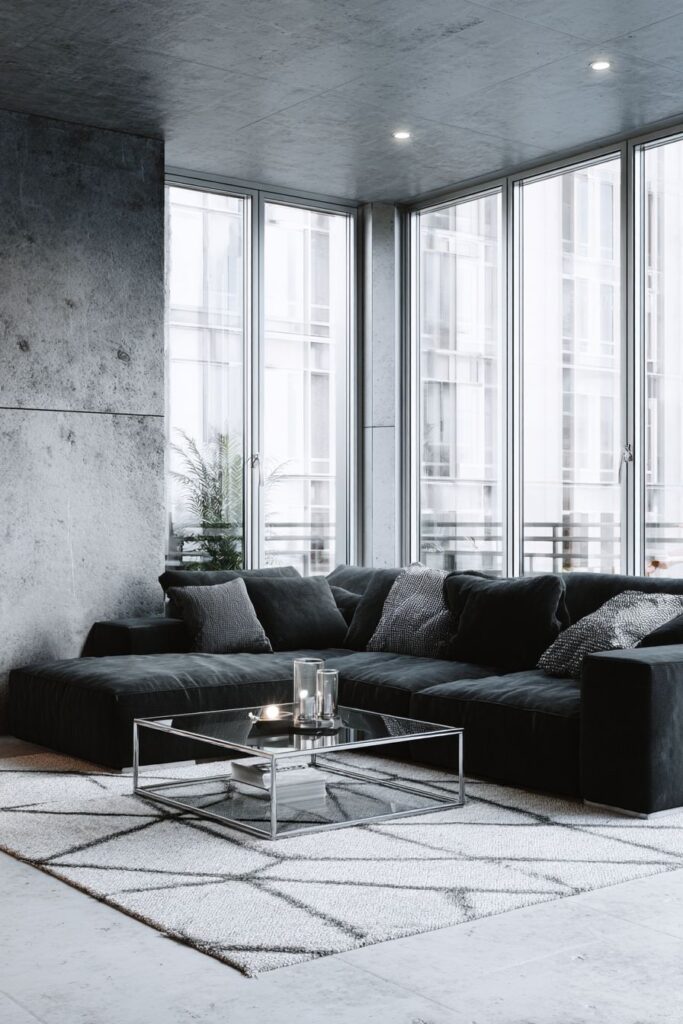
The minimalist steel coffee table maintains the sleek aesthetic while providing essential function through its clean geometric form. A geometric area rug in neutral tones adds pattern and texture to the floor plane while maintaining the sophisticated color story that characterizes contemporary design. These elements work together to create a cohesive environment that feels both current and timeless.
Recessed LED lighting provides even illumination throughout the space while eliminating the visual clutter of traditional fixtures. This approach to lighting demonstrates the contemporary preference for technology that enhances rather than dominates the living environment. Wide-angle interior photography showcases the open-plan layout and sophisticated urban living environment with attention to the material details that make contemporary design so appealing.

Key Design Tips:
- Choose modular furniture that can adapt to changing needs and uses
- Incorporate industrial materials like concrete and steel for authentic urban appeal
- Maximize natural light with large windows and minimal window treatments
- Use LED lighting for energy efficiency and clean, contemporary appearance
- Maintain a neutral color palette that won’t quickly feel dated
11. Eclectic Vintage Collection

The eclectic approach celebrates the beauty of mixing different periods and styles, using a classic Chesterfield-style sofa in deep black leather as the anchor for a carefully curated collection of vintage and modern elements. This traditional sofa form provides visual weight and historical reference while its black color allows it to work with accessories from many different periods and styles. The deep leather upholstery adds richness and texture while developing beautiful patina over time.

An antique brass coffee table introduces metallic elements and traditional craftsmanship details that complement the sofa’s classical proportions while adding functional surface space. A colorful vintage Persian rug creates visual interest through its traditional patterns and time-worn beauty, demonstrating how authentic antique textiles can anchor eclectic design schemes. These foundational elements provide the framework for layering additional collected pieces.

The gallery wall with mixed frame styles displays curated artwork that reflects personal taste and collecting history rather than coordinated design. This approach to wall treatment creates visual interest while telling the story of the inhabitants’ interests and travels. Table lamps with unique ceramic bases provide warm accent lighting while contributing to the collected-over-time aesthetic that makes eclectic design so personally satisfying.
Natural daylight highlights the rich leather patina and varied textures throughout this collected aesthetic, creating dynamic lighting conditions that change throughout the day. The interplay between natural and artificial light sources ensures comfortable illumination for various activities while enhancing the visual richness that makes eclectic design so engaging and personally meaningful.
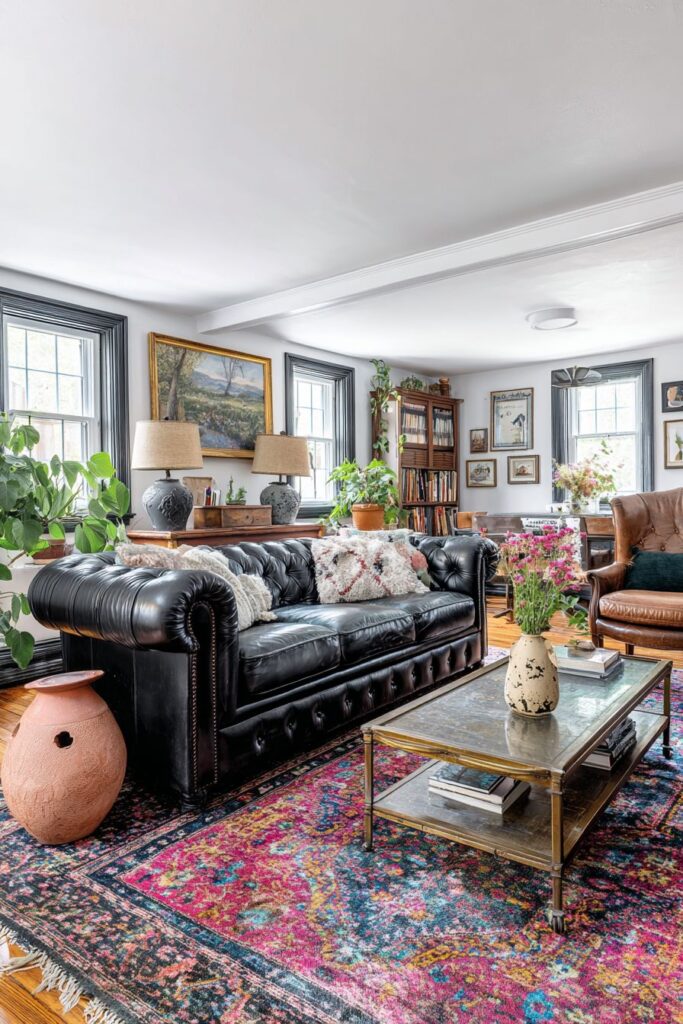
Key Design Tips:
- Mix furniture and accessories from different periods for authentic eclectic appeal
- Use a consistent color thread to unify disparate elements and create cohesion
- Display personal collections and artwork that reflect individual taste and history
- Layer textures and patterns for visual richness without overwhelming the space
- Allow the room to evolve over time rather than trying to complete it all at once
12. Coastal Relaxed Retreat
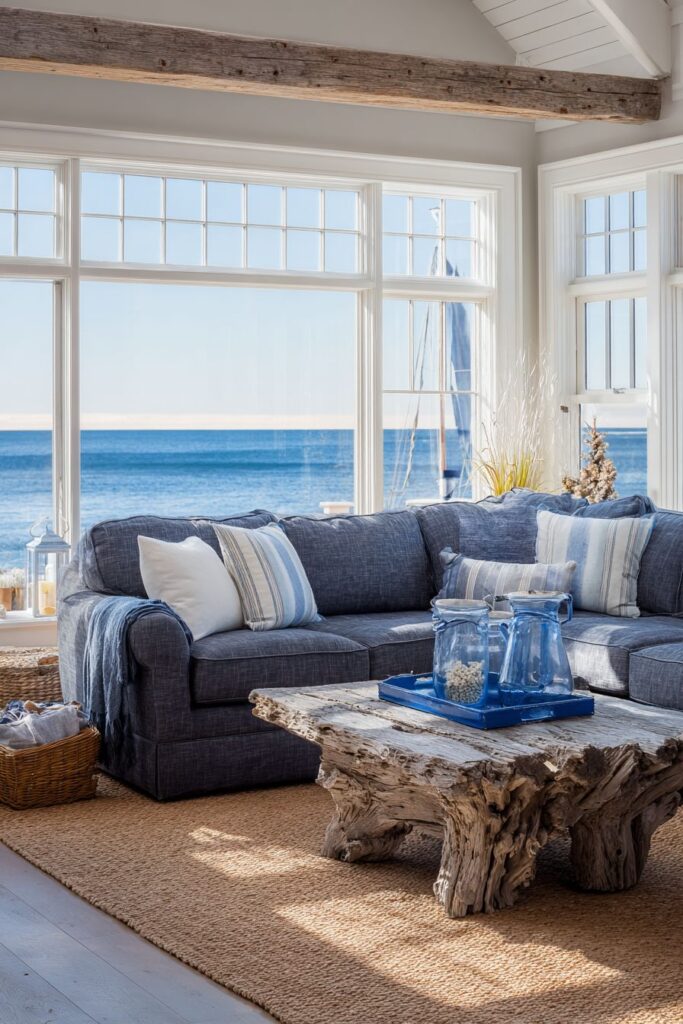
Coastal design captures the relaxed atmosphere of beachside living, using a sectional in charcoal performance fabric as practical seating that can withstand the challenges of seaside environments. The performance fabric provides stain resistance and easy cleaning while maintaining sophisticated appearance, essential qualities for spaces that might encounter sand, salt air, and frequent use by family and guests. The positioning to face ocean views demonstrates the coastal priority of connecting interior and exterior spaces.
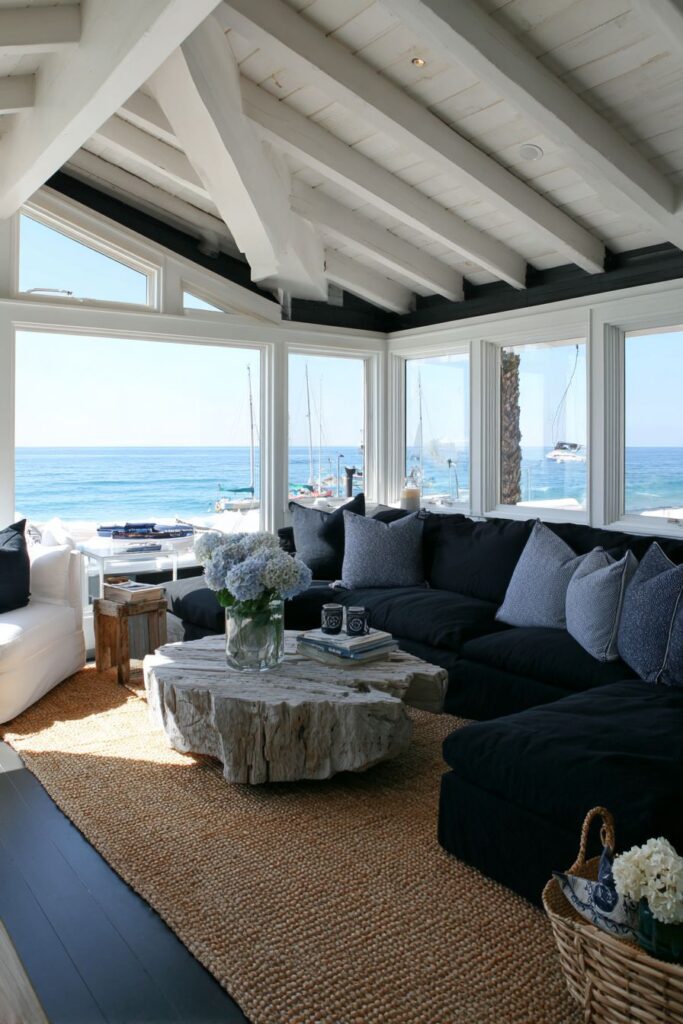
A weathered driftwood coffee table brings authentic beach character into the space while providing functional surface area for books, drinks, and decorative accessories. Natural fiber rugs reinforce the beachy aesthetic while being practical enough to handle sandy feet and frequent cleaning. These organic materials create textural interest while maintaining the casual, unpretentious atmosphere that defines coastal living.
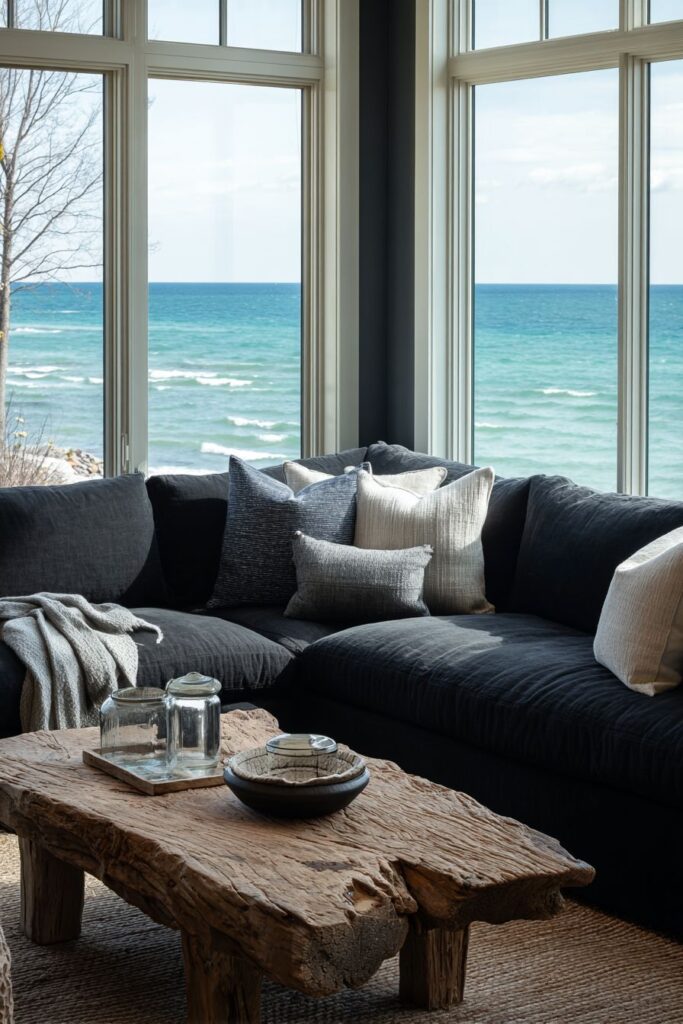
White slipcovered accent chairs provide additional seating while introducing the crisp white elements that are essential to coastal color schemes. The removable slipcovers offer practical benefits for frequent washing while allowing for seasonal changes or updates. Nautical accessories in blues and whites balance the dark seating while reinforcing the coastal theme through carefully chosen decorative elements.
Salt air and natural lighting create the casual, vacation-home atmosphere that makes coastal design so appealing, with large windows ensuring maximum connection to the seaside environment. Professional interior photography captures the serene coastal living environment while showcasing how practical considerations and aesthetic appeal can work together to create spaces that are both beautiful and livable.
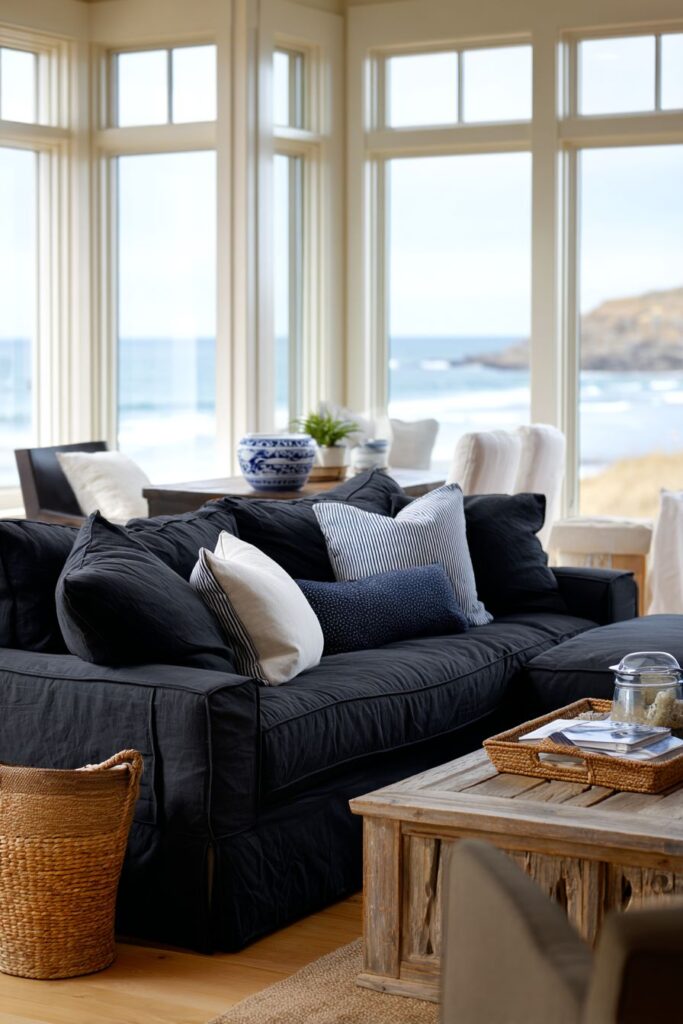
Key Design Tips:
- Choose performance fabrics that can withstand moisture and frequent use
- Incorporate natural materials like driftwood and sea grass for authentic coastal appeal
- Use a palette of whites, blues, and sandy neutrals inspired by the beach environment
- Select furniture with slipcovers for easy cleaning and seasonal updates
- Maximize natural light and views to strengthen the connection with the coastal setting
13. Luxury Opulent Drama

Luxury design embraces rich materials and dramatic elements, making a designer sectional upholstered in premium black velvet with brass nailhead trim the perfect centerpiece for an opulent living space. The sumptuous velvet fabric provides tactile luxury while the brass detailing adds traditional elegance and visual interest through its reflective qualities. This combination of materials creates immediate impact while establishing the sophisticated tone that defines luxury interior design.

A marble coffee table with gold veining introduces natural beauty and classical elegance while providing a functional surface that can withstand daily use. The plush area rug in deep navy creates color depth while adding another layer of luxury through its rich pile and sophisticated hue. These elements work together to establish the material palette that makes luxury design so visually and tactilely appealing.

Crystal chandelier and silk drapery panels add formal elegance while demonstrating the attention to detail that separates luxury design from more casual approaches. The chandelier provides ambient lighting while serving as a sculptural focal point that draws the eye upward and creates dramatic shadows. The silk draperies frame windows beautifully while providing privacy and light control options.
Soft accent lighting highlights the rich fabric textures and sophisticated material palette, creating the layered lighting scheme that’s essential to luxury environments. Interior design photography with dramatic lighting emphasizes the high-end furnishings and refined aesthetic while showcasing how quality materials and expert craftsmanship create spaces that feel truly special and indulgent.
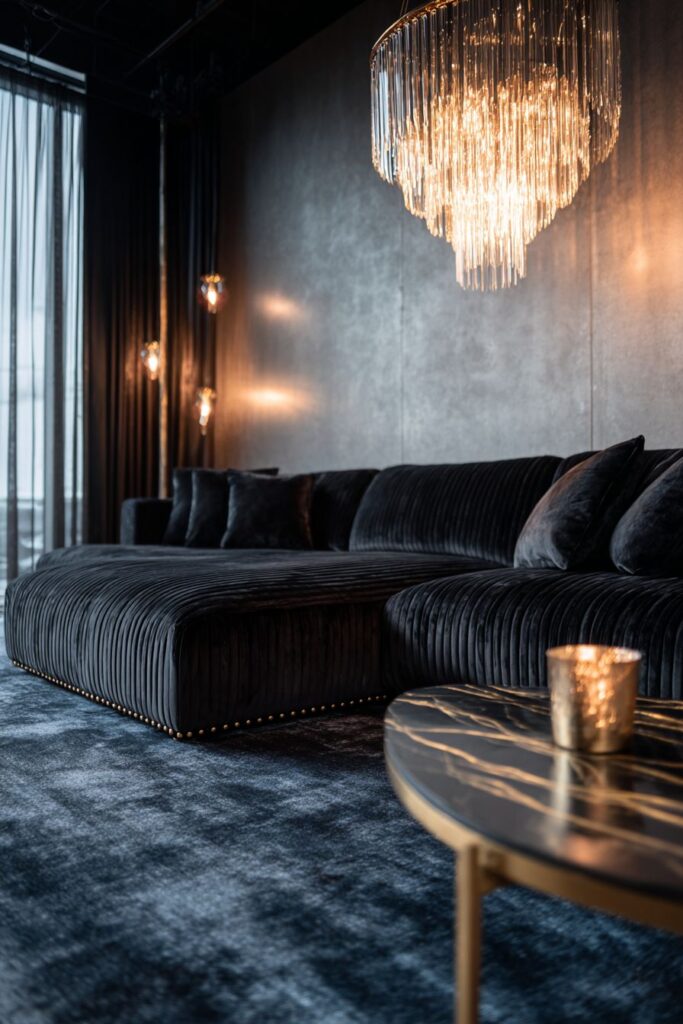
Key Design Tips:
- Invest in premium materials like velvet, silk, and genuine marble for authentic luxury appeal
- Use metallic accents in brass or gold for warmth and traditional elegance
- Layer multiple lighting sources to create ambiance and highlight rich textures
- Choose deep, saturated colors that feel sophisticated rather than trendy
- Pay attention to details like nailhead trim and custom millwork for polished results
14. Minimalist Zen Simplicity

Minimalist design celebrates the beauty of essential elements, using a low-profile sofa with clean geometric lines as the single seating element in a carefully edited space. This approach to furniture selection demonstrates the minimalist commitment to quality over quantity, where each piece must earn its place through both function and form. The stark white walls provide a pristine backdrop that allows the black sofa to read as a sculptural element rather than merely functional furniture.
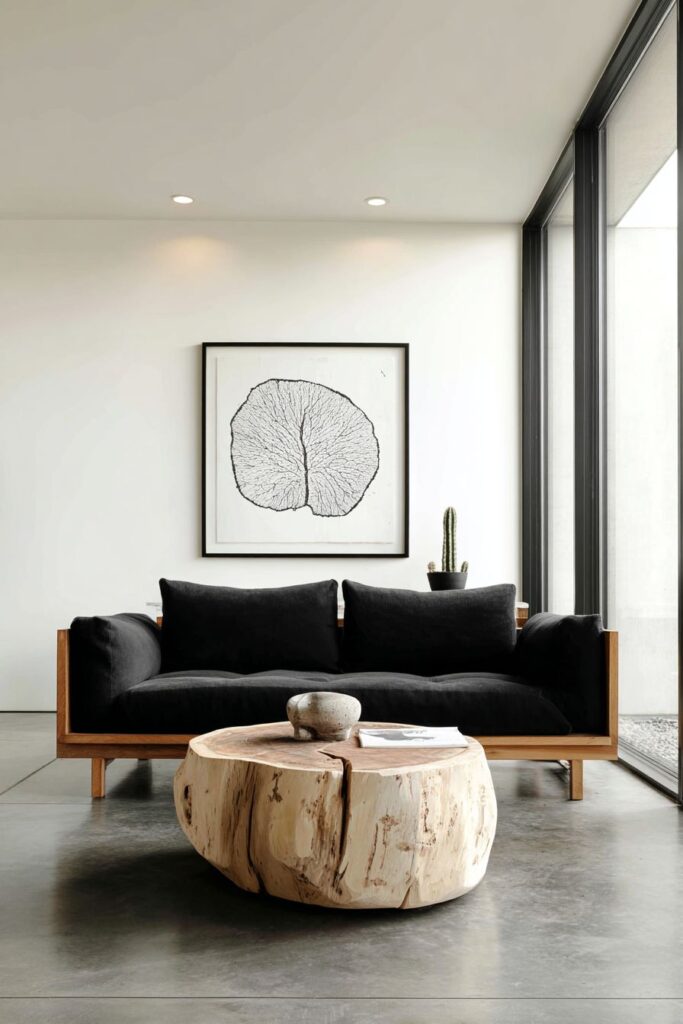
A single live-edge wooden coffee table maintains the pared-down aesthetic while introducing organic beauty through its natural wood grain and irregular edge. Concrete floors reinforce the industrial minimalism while providing durability and easy maintenance. These hard surfaces might seem austere, but they create the neutral foundation that allows carefully chosen elements to have maximum impact.

Large abstract artwork provides the only color accent in this monochromatic scheme, demonstrating how strategic art selection can introduce personality without compromising the overall aesthetic restraint. The artwork serves as a focal point while adding visual weight that balances the horizontal lines of the seating arrangement. Floor-to-ceiling windows maximize natural light while maintaining the serene, uncluttered environment that defines minimalist spaces.
Professional photography with high contrast lighting showcases the powerful simplicity and thoughtful negative space that makes minimalist design so compelling. This approach reveals how the absence of unnecessary elements can create spaces that feel both calming and dramatically beautiful, proving that less truly can be more when executed with skill and intention.

Key Design Tips:
- Edit ruthlessly to include only essential furniture and accessories
- Use high-contrast color schemes for maximum visual impact
- Choose furniture with clean geometric lines that read as sculptural elements
- Maximize natural light to enhance the sense of space and serenity
- Select one statement piece of artwork to provide personality without clutter
15. Family-Friendly Practical Luxury
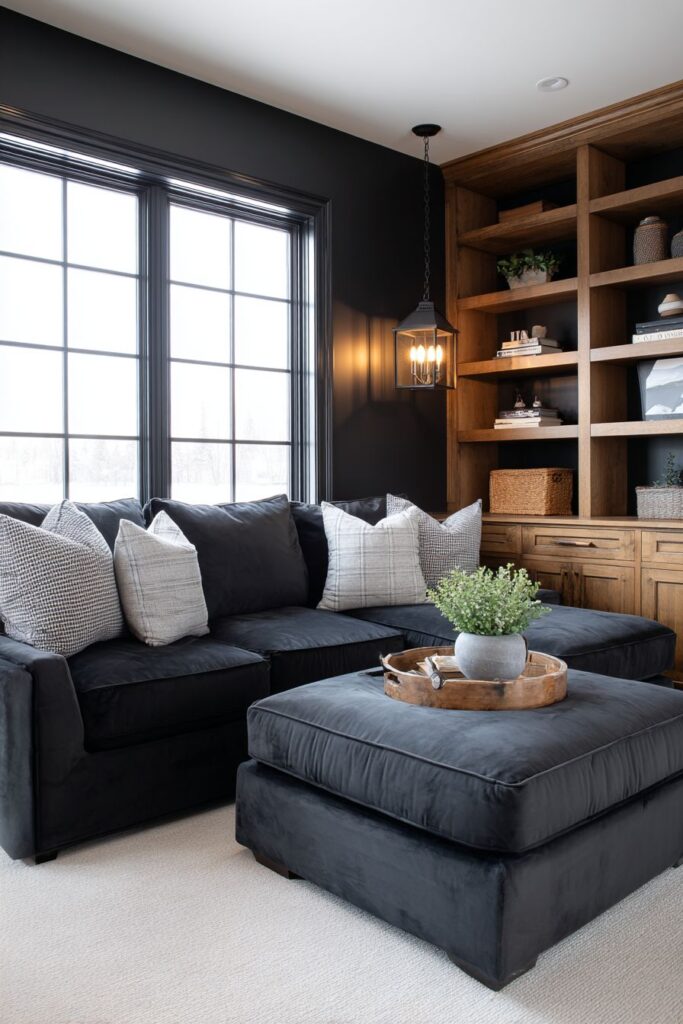
Family living requires furniture that can withstand daily use while maintaining style and comfort, making a durable sectional in charcoal microfiber with rounded corners and deep cushions the ideal choice for active households. The microfiber upholstery provides stain resistance and easy cleaning while feeling soft and luxurious to the touch. Rounded corners enhance safety for young children while contributing to the overall sense of comfort and approachability.

An oversized ottoman doubles as coffee table and extra seating for children, demonstrating the multifunctional approach that’s essential for family-friendly design. This piece provides surface space for games, crafts, and snacks while offering additional seating when friends visit. The soft upholstery eliminates sharp edges while providing a safe surface for children’s activities.
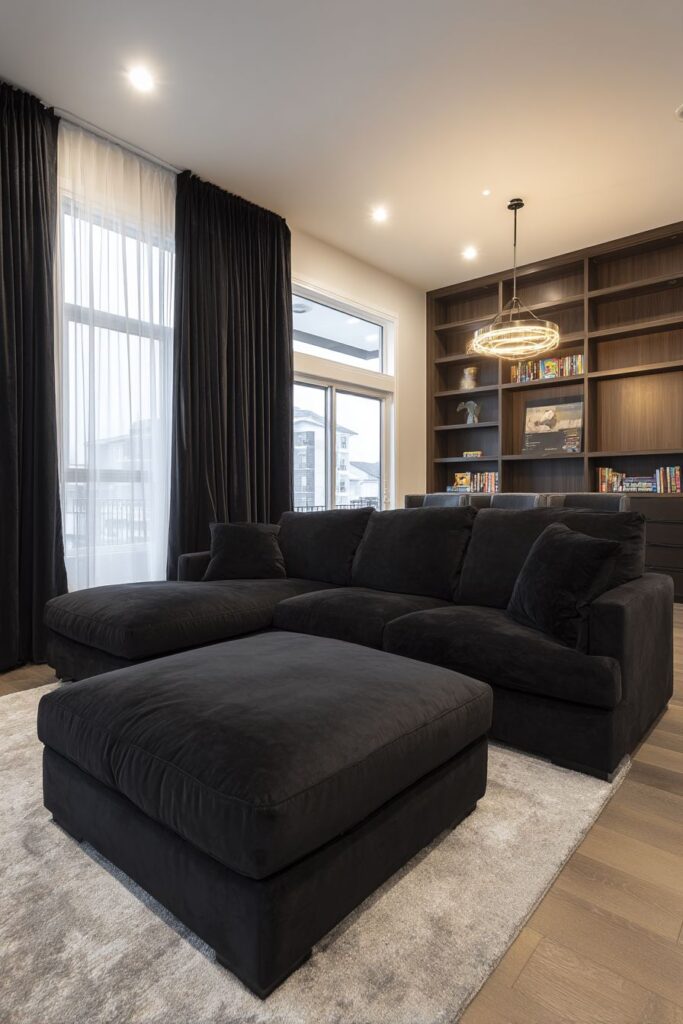
Washable area rugs and built-in storage solutions accommodate toys and games while maintaining the organized appearance that busy families need. These practical elements prove that family-friendly design doesn’t require sacrificing style or sophistication. The storage solutions keep everyday clutter contained while the washable rugs ensure easy maintenance after spills and accidents.
Soft pendant lighting and warm wood accents create a welcoming atmosphere that feels comfortable for both adults and children. Interior photography captures the practical luxury and livable elegance that makes this approach so suitable for active families, showing how thoughtful design can create spaces that are both beautiful and functional for real-world family life.

Key Design Tips:
- Choose stain-resistant fabrics that can handle daily wear and frequent cleaning
- Include multifunctional furniture pieces that adapt to changing family needs
- Provide adequate storage to keep toys and games organized but accessible
- Select furniture with rounded corners and soft edges for child safety
- Create good lighting for various activities from homework to family game nights
16. Rustic Cabin Authenticity

Rustic design celebrates natural materials and authentic aging, using a weathered leather sectional with natural character marks as the centerpiece for a cabin-inspired living space. The leather shows authentic aging and patina that tells the story of use and time, creating furniture that becomes more beautiful with age rather than showing wear. This approach to materials selection demonstrates the rustic preference for authentic rather than artificial aging processes.

A reclaimed wood coffee table and stone fireplace surround emphasize the cabin aesthetic while providing functional elements that enhance daily living. The reclaimed wood brings history and character into the space while demonstrating environmental consciousness through material reuse. The stone fireplace creates a natural focal point while providing warmth and ambiance during cooler seasons.

A cowhide area rug and wrought iron accessories add authentic western elements that reinforce the rustic narrative without feeling contrived or overly themed. These materials reference traditional ranch and cabin life while being durable enough for contemporary use. The natural variations in the cowhide ensure that each installation is unique and personally meaningful.
Warm firelight and strategically placed table lamps create cozy ambient lighting that enhances the authentic materials while providing functional illumination for reading and conversation. Professional photography highlights the rich textures and authentic materials that make rustic spaces feel genuinely inviting and connected to nature and traditional craftsmanship.

Key Design Tips:
- Choose furniture with authentic aging rather than artificial distressing for genuine character
- Include a stone or brick fireplace as the natural focal point for rustic spaces
- Use natural materials like leather, wood, and stone that improve with age
- Add wrought iron hardware and accessories for traditional western authenticity
- Layer warm lighting sources to create cozy ambiance during evening hours
17. Art Deco Glamorous Revival
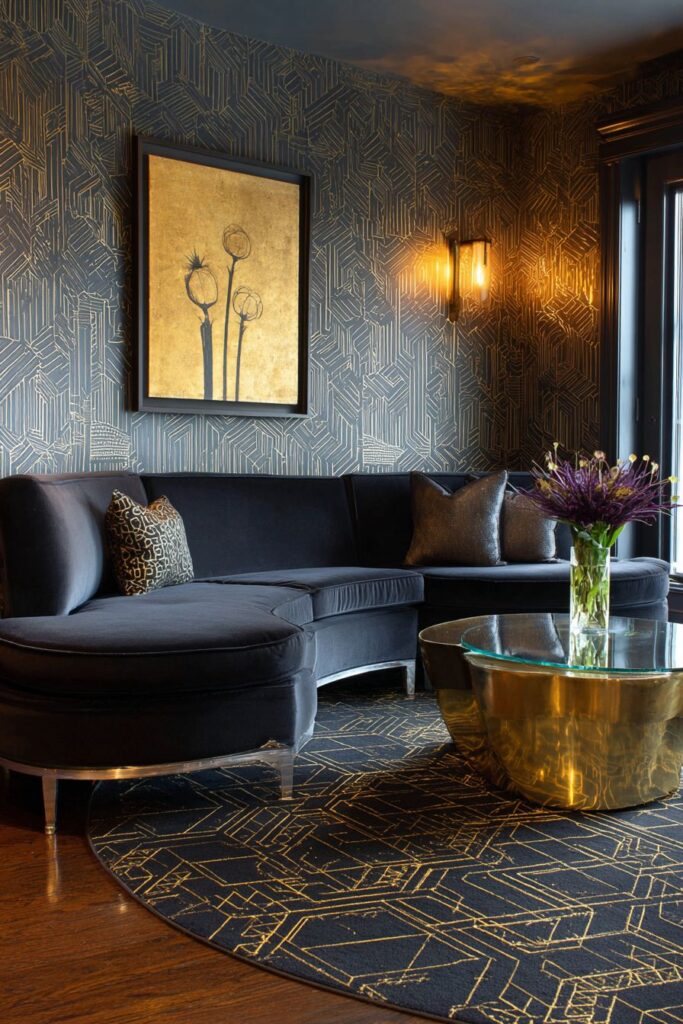
Art Deco design celebrates the glamour and optimism of the 1920s, using a curved sectional with chrome legs and sleek black upholstery to capture the period’s fascination with modern materials and streamlined forms. The curved lines reference the era’s love of sweeping, dynamic shapes while the chrome legs introduce the metallic elements that were essential to Art Deco aesthetics. This furniture combination creates immediate historical reference while maintaining contemporary comfort and scale.
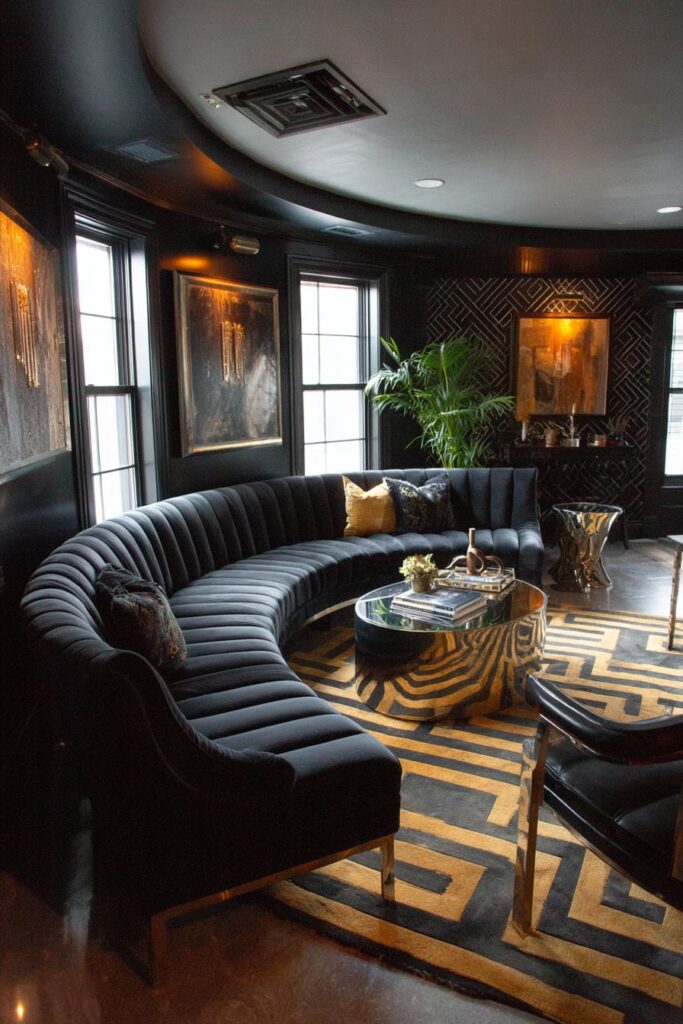
A mirrored coffee table reinforces the period’s fascination with reflective surfaces and geometric forms while providing functional surface space. The geometric area rug in black and gold echoes the bold patterns that defined Art Deco decorative arts while anchoring the seating arrangement. These elements work together to create the sophisticated material palette that makes Art Deco design so visually striking and emotionally appealing.
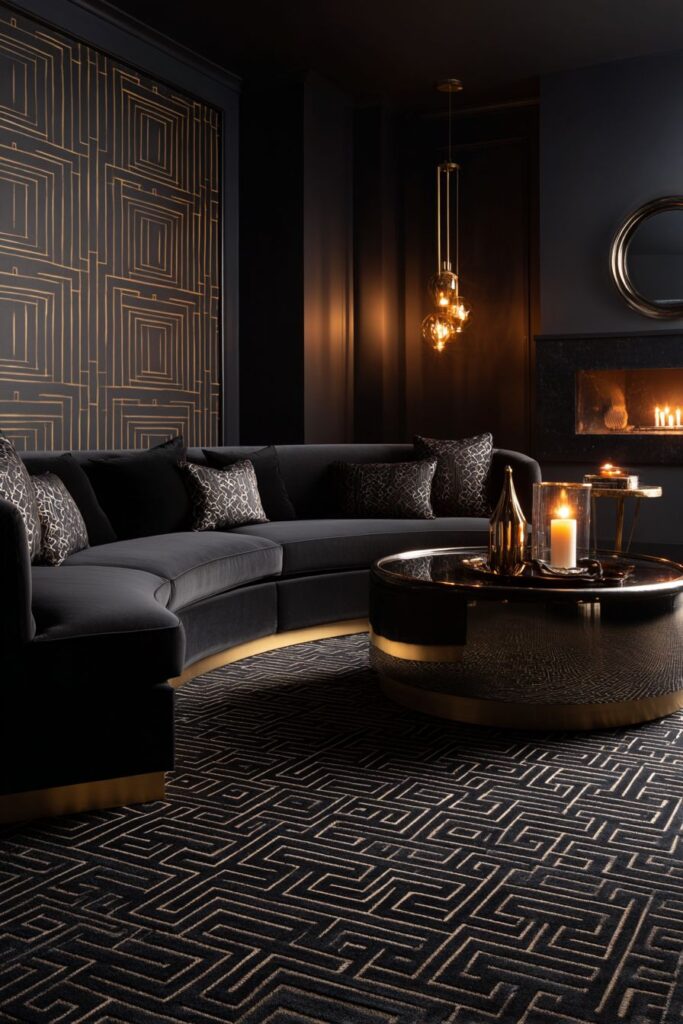
Brass accent lighting and bold geometric wallpaper create dramatic focal points that demonstrate the period’s commitment to theatrical interior design. The lighting fixtures serve both functional and decorative purposes while the wallpaper transforms plain walls into artistic statements. These elements show how Art Deco embraced technology and modern manufacturing to create unprecedented levels of luxury and visual drama.
Professional interior photography with controlled lighting emphasizes the luxurious materials and sophisticated geometric patterns that characterize the Art Deco period. This documentation reveals how attention to detail and commitment to quality craftsmanship can create spaces that feel both historically informed and thoroughly contemporary in their appeal and sophistication.

Key Design Tips:
- Include curved lines and geometric patterns characteristic of the 1920s aesthetic
- Use chrome, brass, and mirrored surfaces for authentic Art Deco glamour
- Choose bold black and gold color schemes for maximum dramatic impact
- Add geometric wallpaper or artwork to create focal points and visual interest
- Include period-appropriate lighting fixtures that serve as decorative sculptures
18. Japandi Peaceful Harmony

Japandi design combines Japanese minimalism with Scandinavian warmth, creating spaces that are both serene and livable. A low-profile sofa in charcoal linen provides comfortable seating while maintaining the clean lines and natural materials that define this aesthetic fusion. The linen upholstery offers textural interest while being practical for daily use, demonstrating how Japandi design balances beauty with functionality.

A natural wood coffee table with clean lines maintains the zen aesthetic while providing essential surface space without visual clutter. The tatami-inspired area rug reinforces the Japanese influence while providing comfort underfoot and helping to define the seating area. These natural materials create the organic foundation that makes Japandi design so calming and personally satisfying.

Subtle indirect lighting and carefully placed ceramic accessories create serene ambiance without overwhelming the carefully edited space. The lighting creates gentle illumination that changes throughout the day while the ceramics add handmade beauty and personal meaning. Large windows frame views of a Japanese garden, strengthening the connection between interior and exterior spaces that’s essential to both Japanese and Scandinavian design philosophies.
Interior photography with soft, even lighting showcases the peaceful harmony and natural material palette that makes Japandi design so appealing to contemporary sensibilities. This approach reveals how the fusion of two distinct cultural aesthetics can create something entirely new while honoring the essential principles of both traditions.

Key Design Tips:
- Combine Japanese simplicity with Scandinavian coziness for balanced appeal
- Use natural materials like linen and wood in their most honest forms
- Include handmade ceramics and other artisanal accessories for personal meaning
- Maintain connection with nature through plants and garden views
- Keep lighting soft and indirect to enhance the serene, meditative atmosphere
19. Loft-Style Open Living

Loft living celebrates spatial generosity and architectural honesty, using a sectional positioned strategically to define the seating area within an expansive open floor plan. This approach to space planning demonstrates how furniture arrangement can create intimate zones within larger spaces without sacrificing the openness that makes loft living so appealing. The black upholstery provides visual weight that anchors the seating area while maintaining sophistication.
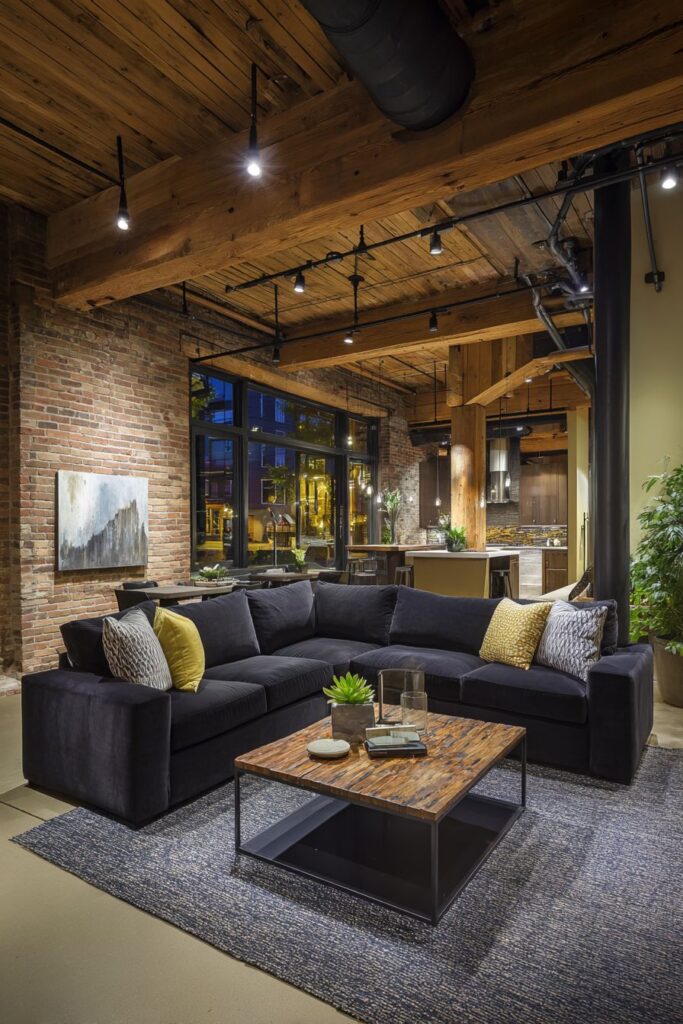
Exposed ceiling beams and polished concrete floors emphasize the industrial architecture while providing the authentic backdrop that defines loft aesthetics. These architectural elements celebrate the building’s original purpose while being adapted for contemporary residential use. The contrast between rough structural elements and refined furniture creates the visual tension that makes loft design so dynamically interesting.

A metal and glass coffee table maintains the urban aesthetic while providing functional surface space without visual heaviness. Track lighting provides flexible illumination options while reinforcing the industrial vocabulary through its exposed hardware and directional capabilities. Large warehouse-style windows flood the space with abundant natural light while maintaining the connection to urban industrial heritage.
Wide-angle photography captures the spacious layout and architectural details that make loft living distinctive and appealing to urban dwellers who value both space and character. This documentation shows how authentic architectural elements can be preserved and celebrated while creating comfortable, sophisticated living environments that honor the building’s history.
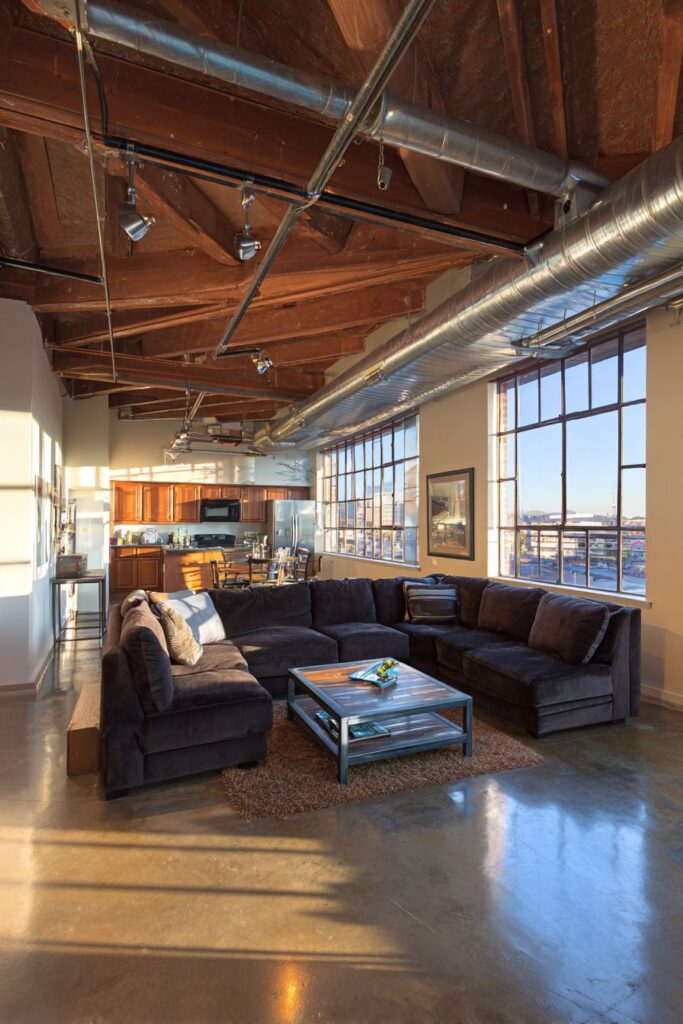
Key Design Tips:
- Use furniture placement to define zones within open floor plans
- Preserve and highlight original architectural elements like exposed beams
- Choose industrial materials like metal and concrete for authentic loft character
- Install track lighting for flexible illumination and industrial aesthetic appeal
- Maximize the impact of large windows and high ceilings through strategic furniture scaling
20. Traditional Formal Sophistication
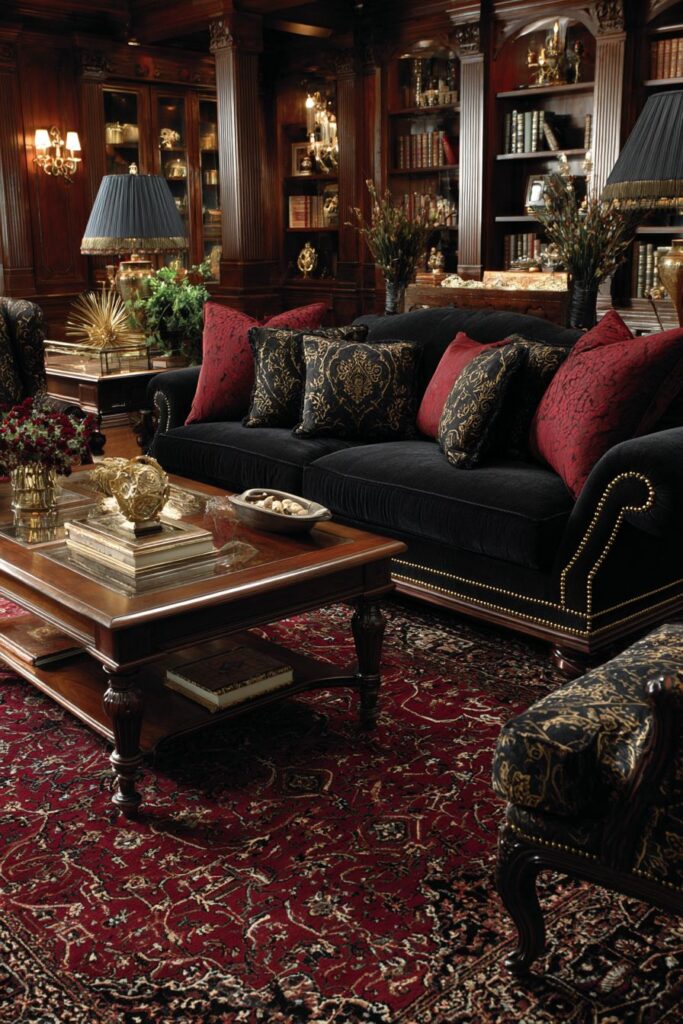
Traditional design celebrates timeless elegance through symmetrical arrangements and quality materials, using a formal sofa with rolled arms and brass nailhead detail as the centerpiece for a classic living room. The traditional proportions and detailing reference historical furniture making while providing comfortable seating for contemporary use. Matching armchairs create symmetrical balance while providing additional seating options for conversation and entertaining.
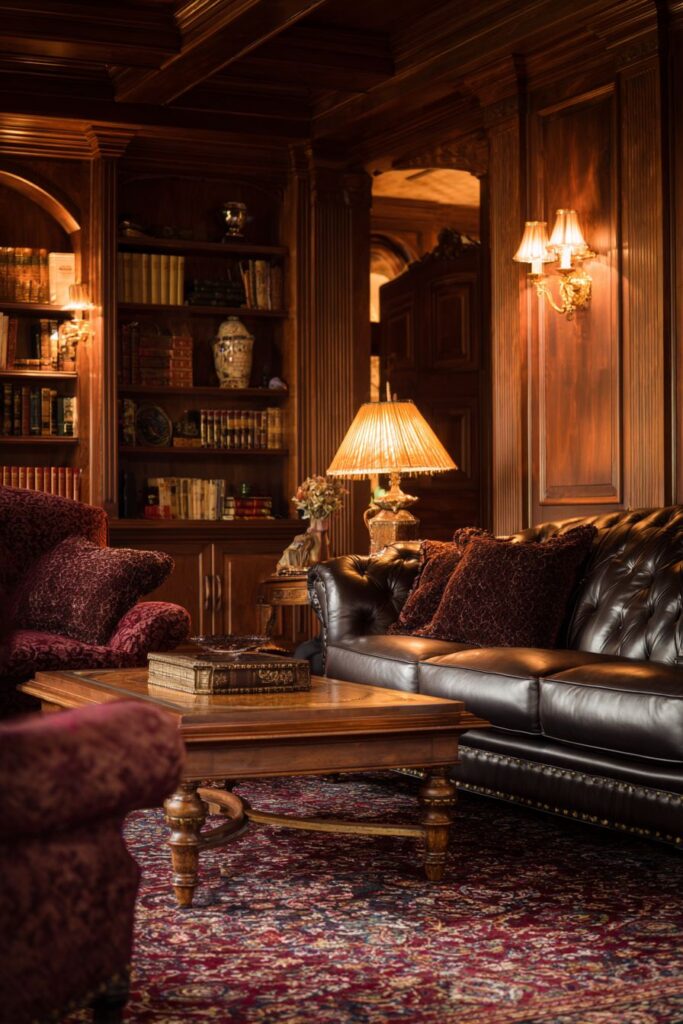
A rich wooden coffee table demonstrates traditional craftsmanship while providing functional surface space for books, refreshments, and decorative accessories. The Persian area rug in deep burgundy adds color richness while establishing the classical foundation that traditional design requires. These elements work together to create the material palette that makes traditional spaces feel both elegant and comfortable.
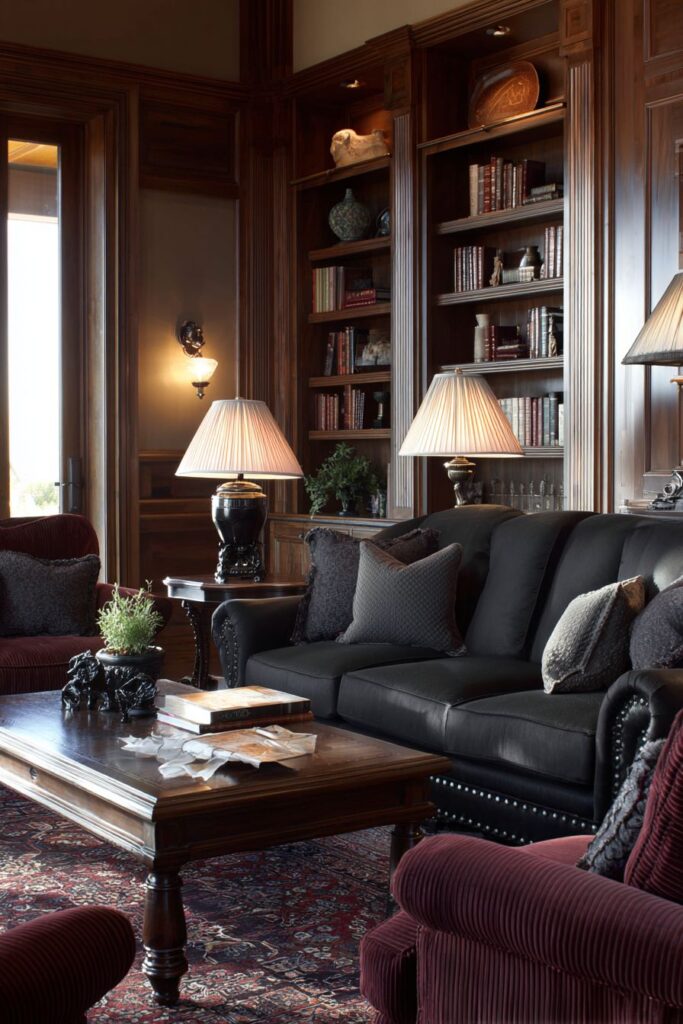
Table lamps with pleated shades provide warm, intimate lighting while contributing to the traditional vocabulary through their classical proportions and traditional materials. Built-in bookcases add architectural interest while providing essential storage and display opportunities for books and collections. These elements demonstrate the traditional commitment to both beauty and functionality in residential design.
Warm incandescent lighting and rich fabrics create an inviting atmosphere that encourages relaxation and conversation. Interior design photography with balanced lighting showcases the timeless sophistication and comfortable formality that makes traditional design enduringly appealing to those who value craftsmanship, quality, and classical proportions.
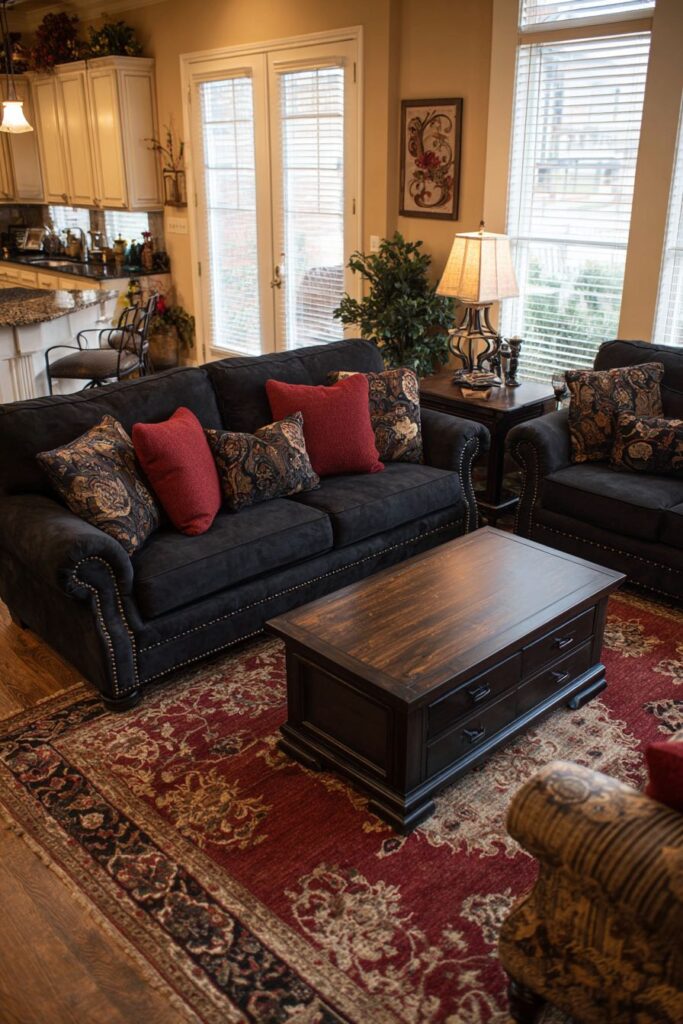
Key Design Tips:
- Arrange furniture symmetrically for traditional balance and formal appearance
- Choose quality materials like solid wood and genuine brass for authentic traditional appeal
- Include Persian or Oriental rugs for classical pattern and color richness
- Use table lamps with traditional fabric shades for warm, intimate lighting
- Add built-in bookcases and millwork for architectural interest and storage solutions
Conclusion
The versatility of the black couch in interior design cannot be overstated. From sleek modern minimalism to cozy farmhouse comfort, from luxurious Art Deco glamour to serene Japandi simplicity, these twenty design approaches demonstrate how a single furniture choice can anchor entirely different aesthetic visions. The key to success lies in understanding how the black couch interacts with surrounding elements—lighting, textures, colors, and architectural features—to create cohesive spaces that reflect personal style while meeting functional needs.
Whether you’re drawn to the clean lines of contemporary design or the rich textures of rustic aesthetics, the black couch provides a sophisticated foundation that can evolve with your changing tastes and lifestyle needs. The beauty of this approach to interior design lies in its flexibility and timeless appeal, ensuring that your investment in quality seating will serve you well for years to come while adapting to new accessories, lighting, and decorative elements.
As you consider implementing these ideas in your own home, remember that the most successful interiors are those that reflect the personalities and lifestyles of their inhabitants. Use these design concepts as inspiration rather than rigid formulas, adapting elements that resonate with your personal aesthetic while maintaining the overall principles that make each approach successful. The black couch is not just a piece of furniture—it’s a design tool that can help you create a living space that’s both beautiful and meaningfully yours.
